Middle School - The Gospels - Overview (Schedule, Recipes, etc..)
CHURCH SCHOOL
THE LIFE OF JESUS – THE GOSPELS
Middle School
This file is provided as a resource for Church School directors. Feel free to plug in your own dates and your own teachers.
TEACHERS:
|
Date |
Lesson/Activity |
Teacher |
Special Notes |
|
September 12
18 19
26
|
Nativity of Theotokos/ Presentation of Theotokos
Movie Night Annunciation
Birth of John the Baptist
|
|
Outdoor, Parish-wide |
|
October 3
10
17
23 24
31
|
Nativity of Our Lord
Meeting of Our Lord
The Three Kings
Movie Night Flight to Egypt
Nazareth and the Temple/ All Saints Party
|
|
Memory Work: St. Simeon’s Prayer
Operation Christmas Child due Dress as favorite gospel character |
|
November 7
14
20 21
28
|
Theophany
Temptations of Jesus
Movie Night Wedding at Cana
Calling of the Fishermen
|
|
Memory : Troparion Jar Decorating
Jewish Dancing
Memory Work: 12 Disciples |
|
December 4 5
12
19
26 |
St. Nicholas Festival Calling of Matthew
Woman at the Well
Christmas Pageant
Sermon on the Mount |
|
10 AM-1 PM in hall
Memory Work: Beatitudes |
|
January 2
9
15 16
23
30
|
Walking on Water/Calming of Storm
Feeding of 5000
Movie Night Transfiguration
The Good Samaritan
Parable of the Sower |
|
Canned Goods 3 Kings Party
Health Kits |
|
February 6
13
17
27 |
Zaccheus
Publican/Pharisee
Prodigal Son
Last Judgment |
|
Homeless Bags
|
|
March 5 6
13
20
27
|
Movie Night Forgiveness/Paralytic
Miracles/Healing
Lazarus
Palm Sunday
|
|
Antiochian Art Contest
|
|
April 2 3
10
17
24 25
30 |
Marathon Movie Night Last Supper
Crucifixion
Resurrection
PASCHA: No Church School Easter Egg Hunt
Rehearsal for Passion Plan/Musical |
|
Memory Work: “Christ is Risen” in 3 languages
|
|
May 1
8
13-15
22
29 |
Passion Play/Musical
Doubting Thomas
Camping Trip Ages 6-12
Myrrh-bearing Women
Road to Emmaeus
|
|
For Parish/Public???
Piggy Banks Due |
|
June 5
12
19 |
Ascension
Pentecost
Lord’s Prayer |
|
Memory Work: Lord’s Prayer Awards Ceremony |
GENERAL NOTES
Classroom supplies: Middle School is supplied with the following items in a box you can carry each week to your classroom; if you use the last of something, please either replace it or let me know so I can replace it. If you need special supplies for your lesson, just submit the receipt to me for reimbursement:
Paper, plain and lined. Tape and dispenser
Stapler and staples Scissors
Colored Sharpies Maps of Holy Land
Pencils Large black marker and large pad of paper
Bible for each student Set of color icons for 12 major feasts
Teaching Schedule: We all know that there will be last-minute needs; trade with someone if you cannot teach on your assigned day and let the director know!
Insurance: Each of us must “apply” each year for our volunteer position of teacher. Please be sure not to send small children to the bathroom unattended and accompany your charges back to the Social Hall after class.
Opening Exercises: The Church School director will supervise this time, or delegate it when she is absent. Church School children and teachers are dismissed first from Liturgy; children come straight across for snack during opening exercises. These are an integral part of the curriculum – reviewing material from previous weeks, presenting additional Old Testament characters, rehearsing plays, hearing memory work, and playing quiz games.
Curriculum: Each of the classes is studying the same material on the same day; therefore the theme of the lesson should be adhered to. However, the actual lesson plan, including Bible reading, discussion, and game for learning the material are open to your own creativity. The class will, through the year, work each week on their own time line of the life of Jesus – adding the scene from the lesson in question with sharpies on their own piece of wallpaper border. Remember to look up the dates of the various events; there will be some spaces and some events crowded together. The first date is BC (Nativity of Theotokos) and the last date is Pentecost. The Bibles have a nice time line to help with placement. In other years, we have worked on a massive wall time line mural of the life of Jesus, with one scene added each week, and, in another facility, that might be a wonderful idea.
Hand-Outs: Feel free to use the puzzles from the Parents' Guide as take homes to reinforce and supplement your lesson.
Movie Nights and Parties: We will have dinner after vespers on Saturday night while showing a small children’s movie. Some nights we’ll also have an overnight with a feature film for the older children; this will be announced in advance. We have several of our usual parties planned: All Saint’s, 3 Kings, Easter Egg Hunt, and, this year, the St. Nicholas Festival. All are invited; please bring friends for an outreach opportunity.
Nativity of Theotokos and Presentation of Theotokos
NATIVITY OF THE THEOTOKOS AND PRESENTATION OF THE THEOTOKOS
Objectives:
- Students should be able to tell the stories of these two great feasts.
- Students should know the names of Joachim and Anna and Mary.
- Students should know the dates of the two feasts.
Possible Lesson Plan:
- Open with prayer.
2. Read the story of the feasts:
There lived in the land of Israel a couple names Joachim and Anna. Joachim and Anna were Jews; God called the Jews His chosen, or special, people, and had given them His law and His prophets. Through the prophets, God had spoken to His special people, telling them that He would send His Son to be their king. And through the years, God had given the Jewish people many mighty and godly kings, like King David and King Solomon. Joachim and Anna were from the family of David because ancestry was traced from the husband’s line. But, tradition tells us that Anna was descended from Levi, of the priestly line, and descendant of Moses. Together – a couple blessed with the heritage of the greatest of the kings of Israel and the greatest of its prophets – king and priest. Little did they know that their grandson, Jesus, would be the King of Kings, the Messiah promised by the prophets, and the highest of all the High Priests.
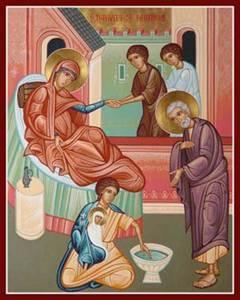 Joachim and Anna were a righteous couple. But despite years of prayers, they had no children and were getting quite old, too old for children. They went to the temple constantly, praying and offering sacrifices for a child. Now, for the Jewish people, not having any children was considered a disgrace; the couple must be very wicked if God would not bless them even with a child. One day, Joachim brought yet another offering to the temple. The priest was so angry to see him yet again that he threw Joachim out of the temple. Joachim went to the hills outside the city and there prayed and fasted for forty days. An angel appeared to him and told him that they would have a baby, and this baby would be blessed by God. The angel appeared at the same to Anna at home. They ran to meet each other at the gates of the city, full of joy.
Joachim and Anna were a righteous couple. But despite years of prayers, they had no children and were getting quite old, too old for children. They went to the temple constantly, praying and offering sacrifices for a child. Now, for the Jewish people, not having any children was considered a disgrace; the couple must be very wicked if God would not bless them even with a child. One day, Joachim brought yet another offering to the temple. The priest was so angry to see him yet again that he threw Joachim out of the temple. Joachim went to the hills outside the city and there prayed and fasted for forty days. An angel appeared to him and told him that they would have a baby, and this baby would be blessed by God. The angel appeared at the same to Anna at home. They ran to meet each other at the gates of the city, full of joy.
Nine months later, the baby was born. She was given the name Mary. The righteous couple promised the Lord that this child would be dedicated to Him; this promise was later fulfilled with the presentation of Mary at the temple.
Several of the early Christian writings of Syria tell us that Mary, the Theotokos was brought to the Temple at age three to be educated, in fulfillment of a vow made by her parents, Joachim and Anna. The feast was instituted in the late 4th century.
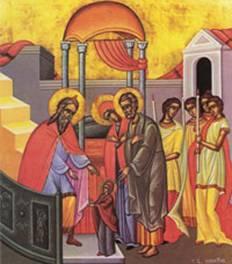 Mary and her parents approach the Temple in joy, accompanied by Mary’s small friends. Zachariah and the Temple virgins meet her in the Temple courtyard. The Temple is divided into three sections: the outer porch or courtyard, the Holy or nave where only Jews can come to pray and worship, and the Holy of Holies, behind a curtain, where only the high priest can enter, and he only once a year on the Day of Atonement. But, little Mary climbs directly up the steps and into the Holy of Holies, astounding all the people
Mary and her parents approach the Temple in joy, accompanied by Mary’s small friends. Zachariah and the Temple virgins meet her in the Temple courtyard. The Temple is divided into three sections: the outer porch or courtyard, the Holy or nave where only Jews can come to pray and worship, and the Holy of Holies, behind a curtain, where only the high priest can enter, and he only once a year on the Day of Atonement. But, little Mary climbs directly up the steps and into the Holy of Holies, astounding all the people
3. Read the story of the feasts: Review the story again, with the icons. Identify each figure. What was the role of each in the story? When is each feast celebrated?
- Discussion questions: Where in the Bible is this account found? (Nowhere, but in ancient Church tradition and the Apocrypha.) Why do we believe that which is not in the Bible? (It is part of the living Tradition of the Church’s memory.) Why is the feast of the Nativity of the Theotokos first in the liturgical year? What is the importance of the Theotokos? In what way, does our hope begin here? What are some other stories of women who prayed and were granted by the Lord “miraculous” babies? (Sarah, Hannah, and later, Elizabeth) In what way do Joachim and Anna fulfill Adam and Eve? How does Jacob’s ladder (Genesis 28) relate to the Theotokos? (She is the ladder who reunites heaven and earth.) Why do Mary’s parents bring her to the Temple? If they love her so much, why give her up? (Similar situation: Hannah and Samuel in I Samuel 1:9-28)
- Historical background: What was the importance of the Ark of the Covenant to the Jewish people? The Temple? Who built the first Temple? (Solomon)Why didn’t God allow David to build it? Who rebuilt the temple after the captivity? (Zerubabel) Who built the Temple that Mary entered? (Herod, who built a Temple to show the Jews how pious he was and to show the Romans the importance of his reign) When was the Temple destroyed and by whom? (the Romans in 70 AD, fulfilling the prophecies of Christ in Luke 19:43-44)
- Service References: Each is a major feast day. Read and discuss the Troparia of the feasts:
Thy Nativity, O Theotokos, hath proclaimed joy to the whole universe; for from thee did shine forth the Sun of Justice, Christ our God, annulling the curse and bestowing the blessing, abolishing death and granting us life everlasting.
Today the Virgin is the foreshadowing of the pleasure of God, and the
beginning of the preaching of the salvation of mankind. Thou hast appeared in the Temple of God openly and hast gone before, preaching Christ to all. Let us shout with one thrilling voice, saying, Rejoice, O thou who art he fulfillment of the Creator’s dispensation.
- Play a learning game – Don’t Make a Move: Write numbers from 1-10 on each of 10 popsicle sticks. Ahead of time, write 10 questions about the lesson on cards numbered from 1-10:
- Who was Mary’s mother?
- Who was Mary’s father?
- What word do we use for God-bearer?
- What is the date of the feast of the Nativity of the Theotokos?
- What is the date of the feast of the Entrance of the Theotokos?
- Where was the temple?
- How old was Mary when she went to the temple?
- What word do we use to mean “birth”?
- Where was Mary born?
(10)Who received Mary at the temple?
The first student dumps the 10 sticks in a pile. He tries to remove one without moving the others. If he succeeds, he can try to answer the question corresponding to the number on the stick. If he moves the other sticks, or cannot give the answer, the stick returns to the pile, and the next student tries. The game is finished when all the sticks are removed and all questions answered.
- Begin your time line and draw in the first two scenes. These, of course, occur “BC”.
- Close with prayer.
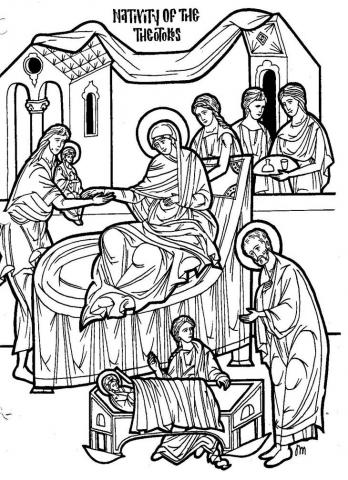
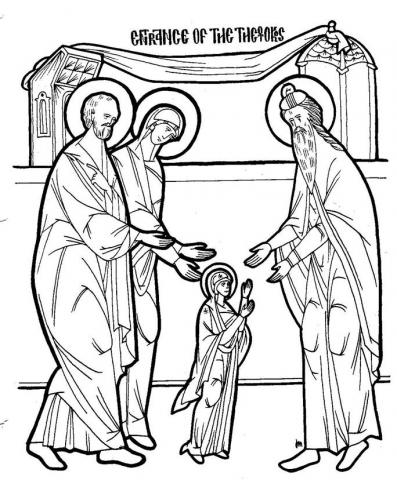
Annunciation
THE ANNUNCIATION
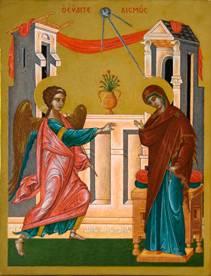 Objectives:
Objectives:
- Students should be able to identify the characters in the icon and tell the story.
- Students should know the date of the feast, March 25.
- Students should know that Mary is the Theotokos and what that means.
Possible Lesson Plan:
- Open with prayer.
- Review the icon: See how much the students already know. There are only two participants, Mary and the Archangel Gabriel. Mary carries a spool of yarn, Why? Because just as sheep give their wool to clothe humanity, Mary gave her body to clothe the eternal Son of God in a garment of humanity. What’s on the scroll in the center? Whose prophecy does it depict? (Isaiah)
- Scripture reading: Luke 1: 26-56
- Songs of the feast:
Troparion: Today is the beginning of our salvation, and the manifestation of the mystery from the ages; for the Son of God becometh the son of the Virgin, and Gabriel proclaimeth grace. Wherefore, do we shout with him to the Theotokos, Hail, O full of grace, the Lord is with Thee.
Oikos of matins: Hail, restoration of fallen Adam:
Hail, consolation of Eve…
Hail, you through whom creation is renewed;
Hail, for through you the Creator becomes a newborn child.
Hail, you Bride unwedded.
- Discussion questions:
What is a mother? Role? Why did Jesus, God Himself, need a mother? (One cannot be born without one!) Who is the Mother of God? What do we call her? What does “Theotokos” mean?
What word does “annunciation” come from? (“announce”) What is announced? Who does the announcing? From Whom does the message come? Where is the announcement made? Is Mary free to make a choice to accept or not accept what God wishes from her? Would you have accepted and why or why not?
What is the Incarnation? (God taking flesh) In what way was it not only the work of the power of God, but also the work and will and faith of the virgin Mary? This is called the “Fiat” – in Latin “so be it” – the union between the wills of the 3 persons of the Trinity (How was each involved?) and with humanity through the agreement of Mary. Why is Annunciation exactly 9 months before Christmas? (Discuss the concept of pregnancy and how it occurs with older students; younger students may want to discuss their own mothers’ pregnancies with a younger sibling, etc.) With older students, a careful discussion of virginity would be appropriate, not however descending into a sex-education class!
What is the relationship between Mary and Elizabeth, the mother of John the Baptist? How long had Elizabeth been pregnant when the Annunciation occurred? Compare and contrast the responses of Mary and of Zachariah when each heard from the angel. What is the Magnificat? (Luke 1:46-55) What are the circumstances where Mary sings this great song of praise and thanksgiving? (She’s visiting Elizabeth) What is the Rosary, spoken by Roman Catholics the world over and where does it come from? (Hail, Mary, full of grace, the Lord is with thee, blessed art thou among women and blessed is the fruit of thy womb, Jesus)
What does the burning bush have to do with the Annunciation? (the bush was filled with God and not consumed, so was Mary) How is Mary the restoration of Adam and the consolation of Eve?
- Play a learning game: Write the letters of the alphabet on small pieces of paper, include at least 2 of each letter and 4 of each vowel. Scatter the letters in the center of the floor. Ask questions from the lesson that can be answered with one word:
Who was the angel who came to Mary?
Who is the Theotokos?
In which feast do we celebrate an announcement?
In which month do we celebrate the Annunciation?
When you say the word, “Go”, the students must sift through the letters to form the word that answers the question. The first to lay out the correct letters is the winner.
- Add to your time line as before.
- Close with prayer.
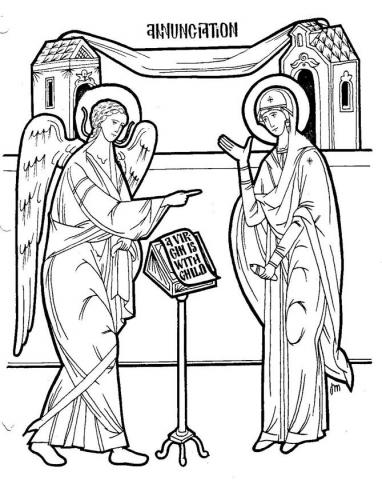
B
Birth of John the Baptist
BIRTH OF JOHN THE BAPTIST
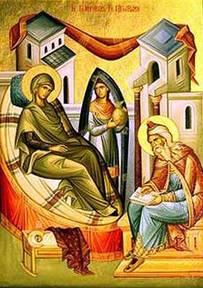
Objectives:
1. Students should be able to tell the story of Elizabeth, Zachariah , and the angel.
2. Students should be able to identify John as the child of Elizabeth and Zachariah.
Possible Lesson Plan:
1. Open with prayer.
2. Read the story of John’s birth in Luke 1:1-25, 57-80.
3. First review the stories of other “gift babies”: Mary to Joachim and Anna, Isaac to Abraham and Sarah, and Samuel to Hannah and Elkanah. What gift did God give to Elizabeth and Zachariah? How did they feel? What did Zachariah say to the angel? Did he believe God? Do you always believe God? Is it hard sometimes to do what God says? Why couldn’t Zachariah speak? What were his first words? Did he obey God in the end? Who visited Elizabeth before John was born? Remind the students that Mary and Elizabeth were cousins.
4. Play a learning game: Make a “Question and Answer Viewer”. Seal a business-size envelope. Cut off both ends, leaving a 6-inch section. Cut two square windows in the front. Label the right window “Question” and the left “Answer” Take a long strip of paper, 3 ½ inches wide and 2 feet long (tape together several shorter lengths). Draw rectangles the same size and distance apart as your windows. In each pair of rectangles, write a question and its answer. Have each student come up with one question for all. Finally, insert the strip into your viewer. As you pull it through, the questions and answers will present themselves!
5. Add to your time line as before.
6. Close with prayer. Use the prayer that Elizabeth prayed when she saw Mary coming: “Rejoice, O Birthgiver of God, Mary full of grace, the Lord is with you! Blessed are you among women, and blessed is the Fruit of your womb. For you have borne the Savior of our souls!”
Nativity
THE NATIVITY OF OUR LORD JESUS CHRIST
Objectives:
1. Students should be able to identify the characters in the icon and tell the story.
2. Students should know the date of the feast (December 25).
3. Students should be able to recite or sing the Troparion and the Kontakion.
4. Students should know the Christmas greeting: Christ is born! Glorify Him!
Possible Lesson Plan:
1. Open with prayer.
2. The icon: Ask how much the students already know about the story of the feast. Who are the characters in the icon? The Theotokos and Child, St. Joseph (being tempted by Satan to doubt the virgin birth), Satan (in dark colors, the Prince of Darkness), a shepherd (facing the angels as they tell of His birth), the Magi (What is their symbolism? 1 beardless and young, one middle-aged, and one old, representing all mankind), the Angels, the cow, and the star. Note: not all icons have the Magi. Is it day or night?
3. Scripture Reference: Luke 2:1-20.
Old Testament prophecies: Can the students find some of these on their own? Psalm 109: 1-4, Micah 4:6-7, 5:2-4, Genesis 14:17-20, Isaiah 8:9-18, 9:1-6, 7:14, 60: 5-6, Numbers 24-15-17, Malachi 3:20. Listen to the songs of the feast for these references.
4. Songs of the Feast:
Troparion: Thy Nativity, O Christ our God, hath shown to the world the light of wisdom. For by it those who worshipped the stars were taught by a star to adore thee, the Sun of Righteousness, and to know thee, the Orient from on high. O Lord, glory to thee!
Kontakion: Today the Virgin gives birth to the Transcendent One, and the earth offers a cave to the Unapproachable One! Angels, with shepherds, glorify him! The wise men journey with the star! Since for our sake the eternal God was born as a little child!
Canon: I behold a strange and wonderful mystery: the cave a heaven, the Virgin a cherubic throne, and the manger a noble place in which hath lain Christ the uncontainable God. Let us, therefore, praise and magnify Him.
5. Discussion questions:
What is Advent? How long is it? How do we observe it? Where was Jesus born? Why there? How did God arrange for the prophecy of Micah to be fulfilled? Was he born in splendor like a king or was God’s Son, the greatest king of all, born in a very humble place? Why? (maybe so we can all reach Him personally) What was a stable in Jesus’s day? (a cave)
Luke traces Jesus’s geneology all the way to Adam, establishing Him as a man; Matthew to Abraham, establishing Him as a Jew. How is He also our priest? (through Melchizadek) Hebrews 7 establishes this clearly.
In what way is the cave a heaven? The Virgin, a cherubic throne? (Remember the Ark from the Feast of the Presentation?)
Where is the peace on earth promised by the angel to the shepherds? Certainly not
on earth at the time of Jesus (remember the Romans?) or since. St. John of Kronstadt answers that “every truly believing person who keeps Christ's commandments, every truly repentant sinner has the peace of Christ within himself, and no external troubles of this world can destroy it.” Do you have that peace inside yourself?
6. Play a learning game: 20 Questions would be great with the multitude of characters. Write the names of the characters in the icon on slips of paper – Mary, Jesus, Joseph, shepherd, cow, angel, star. Have students select a slip of paper. The other students then ask yes/no questions until they can determine the identity of the character.
7. Add to your time line as before. Do you want to include some ancestors in BC?
8. Close with prayer.
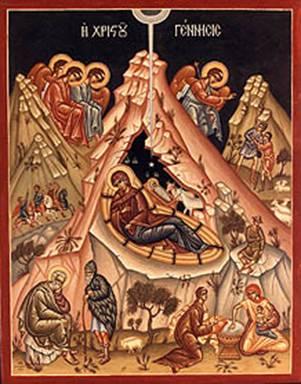
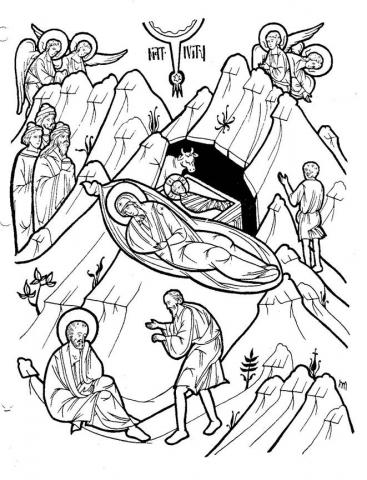
The Meeting of the Lord
THE PRESENTATION OF JESUS/MEETING OF THE LORD
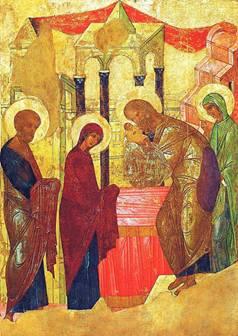 Objectives:
Objectives:
1. Students should understand the icon of the feast and its major characters.
2. Students should know the date of the feast, February 2.
3. Students should understand the connection between this feast and “churching”.
4. Students should be able to recite or sing St. Simeon’s prayer.
Possible Lesson Plan:
1. Open with prayer.
2. Present the icon; see how much the students already know: St. Joseph on the extreme left (why is he so old?), Mary the Theotokos next to Joseph, the baby Jesus, St. Simeon the God-receiver, St. Anna the Prophetess, the entrance to the Holy of Holies, the most sacred section of the Temple.
3. Scripture reading: Luke 2: 22-40
4. Songs of the Feast:
Troparion: Rejoice, O Virgin Theotokos, full of grace; for from thee arose the Sun of Justice, Christ our God, lighting those in darkness. Rejoice and be glad, O righteous elder, carrying in thine arms the Deliverer of our souls, Who granteth us resurrection.
St. Simeon’s prayer (the “Nunc Dimittis”): Lord, now lettest thou thy servant depart in peace, according to thy word, for mine eyes have seen thy salvation, which thou hast prepared before the face of all peoples, a light to lighten the Gentiles, and the glory of thy people, Israel. (Sing it together!) Where does the title “Nunc Dimittis” come from? (the first 2 words in the song in Latin)
5. Discussion questions:
How old was Jesus when brought to the Temple? Why was he brought? (the law of Moses – see Exodus) Who met them? Why were they there? Compare and contrast with a churching? When do we sing St. Simeon’s prayer? What is the symbolism of the passing of the child from Mary to Simeon? (maybe the encounter between Jesus and his people)
The offering of the first-born son to God is a remembrance of what Old Testament event? (Passover), Why would Jesus, the author of the Law, have to obey the Law? Why did Mary and Joseph bring 2 doves instead of a lamb? (on the surface, maybe they were too poor to afford a lamb, but symbolically Jesus is the Lamb of God; they didn’t need another lamb! If you want, review the story of Isaac; so Jesus is brought to the Temple and received by the priest right in front of the altar, a prophetic vision of his future death on the cross.)
Did Simeon and Anna just happen to come to the Temple that day? No, they had waited years, focused on the Lord, waiting for His Messiah. Would we have waited even a day?
In what way is Simeon the “last watchman” of Israel? (See Psalm 129:5-7 – Israel is now ready to share its light with all the nations), Moses was not allowed to see God face to face and Isaiah needed a coal brought by a seraphim from the altar for purification, but Simeon holds God in his arms (As the Aposticha says, “Christ once appeared to the divine Isaiah as a burning coal held by tongs. Now he is given to the elder by the hands of the Mother of God”): Why is the rule of the Old Testament now void with the birth of Christ? (God himself has come as a man and has purified us through his own power to remove all sin.)
What were the prophecies of Simeon and Anna about the Messiah? How were they fulfilled?
How do we today go about Meeting the Lord? St. Theophan the Recluse puts it this way, “establish for yourself a manner of life and conduct that would make every step or movement something directing your attention to our Lord and Savior. Such an order of life will establish itself naturally, if you do everything that you do for the Glory of the Lord and Savior, for Christ's sake. Here we mean not only great deeds, but all deeds. For, seeing and hearing, silence and speaking, food and drink, sitting and walking, work and rest can all be dedicated to the Lord and sanctified by His All-Holy Name. There isn't a minute when we are not doing something; so, by thus dedicating your activity, you will be meeting the Lord minute by minute, directing all of your activities to His glory.” How much of each day are you “meeting the Lord”?
6. Play a learning game: Bible Match. Write each question on a slip of paper and its answer on another. Hand out the slips of paper. Each student must find his partner – the student with the answer to his question. They then sit down together.
Who was the elder God promised he would see the Messiah? // Simeon
Who was the elderly woman who waited in the temple? // Anna
Who was the mother of Jesus? // Mary the Theotokos
Who was Mary’s husband? // Joseph
Who was the Messiah? // Jesus
7. Add to your time line as before.
8. Close with St. Simeon’s Prayer; can you sing it?
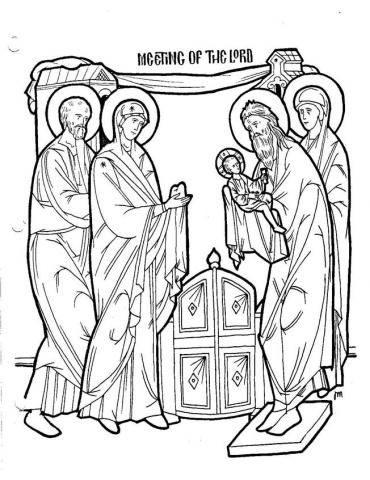
The Three Kings
THE THREE KINGS
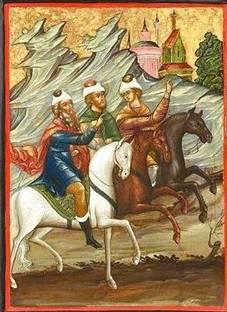 Objectives:
Objectives:
- Students should be able to tell the story of the three kings, or wise men.
- Students should know that the star guided the wise men to Bethlehem.
- Students should be able to name Herod as the king who wanted to kill Jesus.
- Students should be able to name the gifts the kings gave the baby Jesus and know the significance of each.
Possible Lesson Plan:
- Open with prayer. Review St. Simeon’s prayer. Have the students memorized it yet?
- Scripture reading: Matthew 2:1-12. Review the icon of the Nativity. Where are the three kings? Does the Bible actually tell us how many kings there were?
- Discussion questions: What were the gifts of the kings? What might be the meaning of these gifts? (gold for a king, incense for a priest, myrrh for His burial) Why did Herod hate Jesus? What did God tell the wise men to do? Who were the Magi? (highly respected scholars and scientists of Persia, astrologers and the most educated men of their day) Symbolism of these men of high rank coming and bowing before a poor, naked child? (possibly prefiguring the redemption of all the nations, not just the Jews), Symbolism of those traveling from the Orient to the true Orient from on high, following the light of a star to the one true light?
- Play a learning game: The Big Step. Line up all the students against a wall. The opposite wall is the finish line. Each player must in turn answer a question about today’s lesson. If successful, he advances one step, as large as he can make it, towards the finish line. Some sample questions:
Who was the king at the time of Jesus’s birth?
What did the magi follow to find the baby?
Where was the baby Jesus?
What were the 3 gifts brought by the magi?
To what city did the magi go first?
How many magi were there according to the Bible?
The magi came from what direction?
Where did the magi go after leaving Bethlehem?
5. Add to your time line as before.
6.Close with prayer.
Flight to Egypt
FLIGHT TO EGYPT
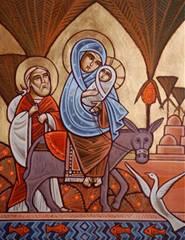 Objectives:
Objectives:
- Students should know the angel Gabriel warned Joseph.
- Students should learn that the Holy Family was accompanied in their journey by James, oldest son of Joseph by his previous marriage.
- Students should be able to identify Egypt historically and on a map.
- Students should name Herod as the king who killed the children of Bethlehem, in fulfillment of prophecy.
Possible Lesson Plan:
1. Open with Prayer.
2. Scripture Reading: Matthew 2:13-23. Who warned Joseph? Who wanted to kill Jesus? Why? Where were Joseph and Mary and Jesus living and where did they go? Tradition teaches us that Joseph had been married before to Solomonia; he was widowed and had 4 sons and 2 daughters when he married the Theotokos. The eldest of these sons, James, accompanied the Holy Family to Egypt. Why Egypt? At the same time, tradition teaches us that Elizabeth escaped the massacre with the baby John into the wilderness, where the angel of the Lord provided a cave for them and watched over the baby John, and that his father, Zechariah, on being questioned by the soldiers as to where his son was hiding, refused to answer and was killed right in the temple.
3. Discussion questions: Historically what is the importance of Egypt? Review the stories of Joseph and Moses. Symbolism of Jesus also coming out of Egypt? Initiate a map search. Where are the countries: Phoenicia, Egypt, Galilee, Samaria, and Judea? Add in the rivers (Nile and Jordan), lakes (Dead Sea and Sea of Galilee) and the Mediterranean Sea. Where’s Sinai? Now for cities: Find Jerusalem, Jericho, and Bethlehem in Judea; Nazareth and Capernaum in Galilee, Caesarea on the Mediterranean. Retrace the path of Jesus from Annunciation in Nazareth to Bethlehem to Jerusalem (for the Meeting in the Temple), back to Bethlehem, then to Egypt, and finally to Nazareth. For future reference, locate Samaria, Capernaum, and Jericho. Use the maps in your box as illustrations, but have the students mark their own for learning.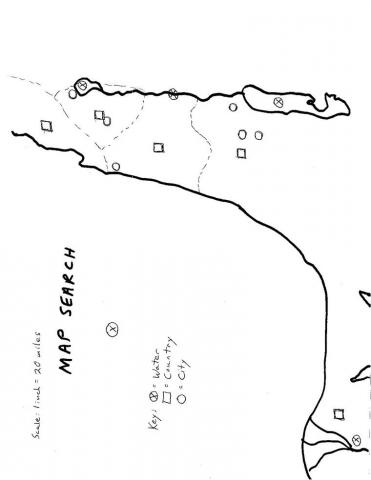
Talk a bit about the role of prophecy. Many prophecies were fulfilled in the life of Jesus; God had prepared His people well to recognize the Messiah through the many prophecies in the Old Testament. Can the students name some that have already been fulfilled? (born of a Virgin, born in Bethlehem, of the house of David, seen by Simeon, John’s birth as the forerunner) Read Jeremiah 31:15. How was this prophecy fulfilled?
4. Historical background: Who ruled in Israel? Review the rulers of Israel from the Old Testament – the judges (e.g. Gideon, Samuel), the first king Saul, David, Solomon, and finally the rule of the Babylonians and Persians. Do the students remember the rule of the Greeks, under Antiochus, in the story of Hanukkah. At the time of Jesus, Rome had ruled Israel for 100 years. But, they ruled it with a king – King Herod (the Great???). Herod tried to win the love of the people by rebuilding the temple, but he was hated and feared for his throne. When he died, during Jesus’s childhood, his kingdom was divided among his three sons. This went so badly, that the Romans finally stepped in and, by the time of Jesus’s crucifixion, the land was ruled by a Roman governor, or procurator, named Pontius Pilate. The kings remained as figureheads but were powerless.
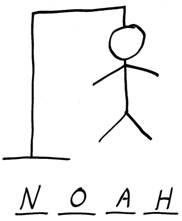 5. Play a learning game: Try “hangman”. Write the names of various people from the story on slips of paper. The student draws a slip of paper and then draws a hangman’s noose and lines for each letter of the name. Other students in turn name letters. If the letter is in the name, the student writes it in. If the letter is not in the name, the student draws a part of a stick figure being hanged. Students try to guess the identity of the person before the man is hanged.
5. Play a learning game: Try “hangman”. Write the names of various people from the story on slips of paper. The student draws a slip of paper and then draws a hangman’s noose and lines for each letter of the name. Other students in turn name letters. If the letter is in the name, the student writes it in. If the letter is not in the name, the student draws a part of a stick figure being hanged. Students try to guess the identity of the person before the man is hanged.
Joseph
Mary
Jesus
Gabriel
Herod
6. Add to your time line as before.
7. Close with prayer.
Nazareth and Trip to Jerusalem
NAZARETH AND THE TRIP TO JERUSALEM
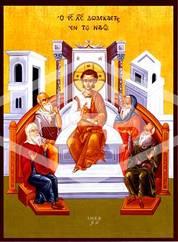 Objectives:
Objectives:
1. Students should identify Nazareth as the childhood home of Jesus and locate it on a map.
2. Students should be able to relate the story of the trip to Jerusalem and Jesus talking with the elders in the Temple.
3. Students should be able to identify the words – high priest, priest, Levite, Sanhedrin, rabbi, scribe, Pharisee, Sadducee, Zealot, temple, synagogue – and know the role of each.
Possible Lesson Plan:
1. Open with prayer.
2. Scripture reading: Luke 2:40-52. Why did the family come back from Egypt? Why did they settle in Nazareth instead of returning to Bethlehem?
3. Historical background: It is important to recognize and understand the roles of the various religious places and groups if one is to understand both the trip to Jerusalem and Jesus’s later ministry. See if the students already know any of these important people and places and help them to understand them better:
- Temple: There was only one temple, in Jerusalem. There was the Ark of the Covenant and sacrifices were offered. People who lived far away would try to make a pilgrimage to the Temple at least once in their lives.
- Synagogue: Each town had its synagogue, where on Sabbath the people came to listen to the Scriptures being read. The synagogue was also the local school. But no sacrifices could be offered here; there were no priests.
- Priest: Priests, descendants of Aaron (Remember the story of the rod that budded?), offered sacrifices in the Temple. The High Priest entered the Holy of Holies once a year to sacrifice for all the people.
- Levites: One of the twelve tribes of Israel (Remember the brothers of Joseph; one was Levi). Instead of receiving land, the Levites served in the Temple with the priests.
- Sanhedrin: The Jewish Supreme Court, composed of the high priest, all previous high priests, all the heads of the tribes and heads of the political parties – 71 in all.
- Rabbi: A local teacher who served to read and explain the Scriptures.
- Scribe: Those who copied the Scriptures as the scrolls wore out and set down rules for every occasion from the books of the law.
- Pharisee: Synagogue leaders who carefully studied and obeyed the Law.
- Sadducees: Rich landowners who supported the Roman rulers and were not interested in changing the government.
- Zealots: Rebels who hated the Romans and thought the Messiah would come as a fierce warrior king to oust the Romans and return Israel to the Jews.
- Gentiles: All of the people of the world who are not Jewish.
4. Play a learning game: Pictionary. Write the words defined above on pieces of paper. Have the first player choose a word and draw it, with the rest of the class guessing the identity. Play then passes to the next student until all words are identified.
5. Add to your time line as before.
6. Close with prayer.
Theophany
THEOPHANY
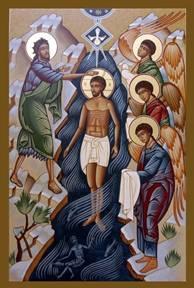 Objectives:
Objectives:
- Students should be able to discuss the icon, knowing each character and its role.
- Students should know that Jesus was baptized in the Jordan River and be able to locate it on a map.
- Students should know the date of the feast, January 6.
- Students should be able to sing the Troparion, since they will need that for their house blessing.
Possible Lesson Plan:
- Open with prayer.
- The icon (Use this to see how much the class already knows and to retell the story.): Christ, the central figure, St. John the Baptist (why is he dressed in brown animal skin?), the angels, the Holy Spirit in the form of a dove, the river Jordan
- Scripture readings:
Gospel: Matthew 3:13-end of chapter, Luke 3:1-18, John 1:19-37
Old Testament prefigurings: Genesis 6:5-8:22 (the Flood (water) and the olive branch (oil)), Isaiah 1:16-18, Exodus 14:21-29 (Moses crossing the Red Sea), I Kings 18:30-39, II Kings 2:11-13
- Songs of the Feast:
Troparion: When thou, O Lord, wast baptized in the Jordan, the worship of the Trinity was made manifest. For the voice of the Father bore witness to Thee, and called Thee His beloved Son, and the Spirit in the form of a dove confirmed the truthfulness of His words; O Christ Our God who hast revealed Thyself and hast enlightened the world, Glory to Thee!
Practice singing the Troparion; this is the week’s memory work.
- Discussion questions:
Who was the last and greatest prophet of Israel? (John) How were the Jewish people prepared to be “shown” the Messiah? Did John recognize Jesus when He arrived? In what ways is John the new Elijah? (Elijah’s mantle of prophecy was passed on to Elisha and from him in an uninterrupted chain of prophets, of whom John is the last)
How old was Jesus when He was baptized? How had He lived up until this time? (as an ordinary working man, a carpenter, in Nazareth) Did Jesus need to be baptized because He was a sinner? Then why was He baptized? (He was fulfilling His responsibility to represent all of creation in being cleansed.)
What does Theophany mean? (Theos meaning “God” and Phanos meaning “to show”) We meet here the Trinity for the first time in the New Testament. How was the Trinity present at Theophany? We reaffirm the 3 natures of the one God every time we make the sign of the cross. How? Why do we bless the water at Theophany? What do we use it for through the year? (house blessing, illness, etc.) The feast is sometimes called “Epiphany”; what does that mean? (“Manifestation”) Why was January 6 chosen for the feast? (to replace the pagan feast of the winter solstice) The Roman Church celebrates the Magi on this date; when do we honor the Magi? (December 25)
In what ways is baptism like the crossing of the Red Sea? (Pharoah, representing Satan, was wiped out just as evil is drowned forever in the waters of baptism; the column of fire protecting the people as the Holy Spirit sanctifies the waters of baptism), John baptized with what? Jesus baptized with what?
- Review the custom of House Blessing. When do we bless houses? Who blesses them? What do we use? Where do we get the Holy Water? What do we sing?
- Ask the students if they have ever seen a baptism? What’s it like? Why are we baptized? (to become part of God’s family, the Church) Sing together “As many as have been baptized…” How was Jesus’s baptism like our baptisms? Different?
- Play a learning game: Play “Final Jeopardy”. Write each important word from today’s lesson (e.g. Theophany, John the Baptist, dove, January 6, Jesus, Noah, Elijah) on a card. Each student should have 7 cards. When the teacher shows the answer card, each student should write a question for which that would be the answer. The students turn their question cards over until all are ready. Show the questions and each correct answer gets 10 points; wrong answer loses 5. Continue through all 7 answers and questions.
- Add to your time line as before.
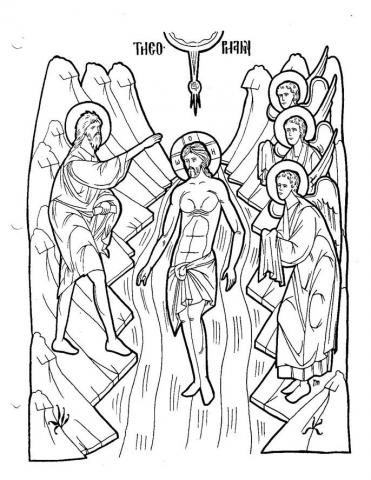
- Close with the Troparion and prayer.
Temptations
TEMPTATIONS
Objectives:
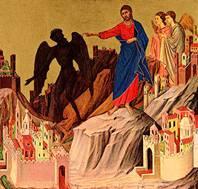 1. Students should identify the devil, Satan, as the one who tempted Jesus.
1. Students should identify the devil, Satan, as the one who tempted Jesus.
2. Students should be able to list the three temptations in order.
3. Students should know that Jesus did not sin.
Possible Lesson Plan:
1. Open with prayer.
2. Scripture references: Luke 4:1-13 and Matthew 4:1-12. Where did Jesus go after his baptism and why? St. John Chrysostom explained it in this way: “Think of a wrestler. In order for him to teach his students how to wrestle and win, the wrestler himself gets into a contest with others. He shows his students what to do, so that they can learn to defeat their opponents.”
3. Discussion: Who is the devil? (Satan, a fallen angel) Review the stories of Adam and Eve and their temptation and of Job. What is the devil’s role in each? What do the godparents do to the devil at a baptism and why?
He tempted Jesus in three ways. What was the first? (food) Jesus had been 40 days without food. Was Jesus man or God? Was He hungry? How did Jesus answer the devil? Will God provide our needs?
What was the 2nd temptation? (jump off the temple and show off His
power) What did the devil quote to Jesus? (Scripture) the whole verse? (NO, only part of the truth) Here we see that the devil is a liar and sneaky. What did Jesus answer?
What was the 3rd temptation? (all the kingdoms of the world – power and
wealth) What does this tell us about Satan? (He has the power to give away riches, but at a price) Is the devil weak or strong? Who is stronger, God or the devil? How did Jesus answer?
4. Ask some questions: What are some temptations faced today? Take chart paper and make headings: School, Home, Play, any others the students can come up with. Brainstorm for situations where the student would be tempted to disobey God. A lost $20 bill found in the playground? Cheating on a test? Lying to get out of trouble? Pocketing a small bottle of nail polish at the dimestore? What would Jesus want us to do in these situations? The devil? Is it a sin to be tempted? Or to choose to do wrong?
5. Play a learning game: Tempters and Resisters. Divide the class into Tempters and Resisters in pairs. Each tempter must pose a temptation in his own words and the resister must counter it (specifically, not just as “no”). Act out each situation for the class. Then change roles and do it again!
6. Add to your time line as before. How will you picture the devil – with horns
and a tail or wings?
7. Close with prayer.
Wedding at Cana
WEDDING AT CANA
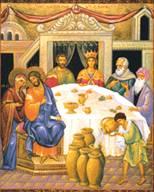 Objectives:
Objectives:
1. Students should identify the water into wine as Jesus’s first miracle.
2. Students should know the word “miracle” and what it means.
3. Students should recognize that the wedding at Cana is part of our wedding service.
Possible Lesson Plans:
- Open with prayer.
- Scripture Reference: John 2:1-11. Why was Jesus in Cana? Who asked him to supply more wine? How was the wine supplied? Remind the students that this was Jesus’s first miracle.
- Discussion: What is a miracle? How do we recognize that a miracle has occurred? Does nature follow a common pattern? Apples fall down, grapes turn to wine, etc. If an apple flew up or water turned to wine, people would notice. Why? What were some types of miracles Jesus did? Brainstorm a bit – healing, raising people from the dead, casting out demons, changing nature. Watch for these in later lessons.
- Talk a bit about weddings. What are the parts of an Orthodox wedding service? (Betrothal, Crowning, Prokeimenon, Gospel, Procession, Cup of wine, Removal of crowns) What happens after the ceremony? (reception/party) What’s a party like? What do you like to have at a party? What might adults like to have? What would it be like to run out of drinks with all those guests?
- Plan a party! Very shortly, we’ll be having our St. Nicholas party and inviting the whole neighborhood. Pretend you’re the steward. Plan it for us – refreshments, activities, games. Just tell us what to buy. And after class today you can deliver the invitations all over the neighborhood!
- Usually, there’s singing and dancing at a Jewish wedding. If you know any Jewish dances, you could do them now, or ask Dr. Pat to visit with her accordion.
- Play a learning game: “Quotations”. Read quotations from the Scripture passage and have the students identify the speaker. For example:
“Fill the waterpots with water.” Jesus
“They have no wine.” Mary
“You have kept the good wine until now.” Steward
“Whatever He says to you, do it.” Mary
“My hour has not yet come.” Jesus
“Draw some now and take it to the headwaiter.” Jesus
- Add to your time line as usual. This is a fun story of a party!
- Close with prayer.
Calling of the Fishermen
CALLING OF THE FISHERMEN

Objectives:
- Students should be able to name all 12 disciples.
- Students should be able to tell the story of the miracle of the full nets.
- Students should know that Jesus’s closest followers were called “disciples”.
Possible Lesson Plan:
- Open with prayer.
- Scripture references: Matthew 4:18-22, Mark 1:16-20, and Luke 5:1-11. When did Jesus first meet Andrew? (He was a follower of John the Baptist.) Why is Andrew called the “First-called”? Who was Andrew’s brother? (Simon, later named Peter by Jesus) Who were the sons of Zebedee, also brothers? (James and John) Why were they called the “Sons of Thunder”? What do you think Peter said when he saw all those fish in his net? Why did the fishermen give up fishing to follow Jesus?
- Talk a bit about being a disciple. What is a disciple? (a person who follows the teachings of a teacher) Jesus had 12 close disciples, but many followers. What did the fishermen have to do to become Jesus’s disciples? Did they enjoy fishing? How do you think they felt leaving their homes and families? Was it easy being a disciple? We are also Jesus’s disciples. What does Jesus ask us to do? Is it always easy? Look at the story of the rich, young ruler in Luke 18:18-23; what did Jesus ask of him? He was a “nice guy”, not a horrible sinner, but was he a disciple? Why or why not?
Sometimes we are confused by the reference to disciples and apostles. Many of these men were the same. Disciples are students and followers. Apostles are people sent forth to do something – in this case to teach the world about Jesus. Which disciple never became an apostle? (Judas Iscariot)
- Begin to list and memorize the 12 disciples: Peter and Andrew, James and John, Matthew, Philip and Nathaniel Bartholomew, Simon the Zealot, James (the Less), (Doubting) Thomas, Judas, and Judas Iscariot.
- Play a learning game: Concentration. Write the name of each of the 12 disciples twice in random order in rows on the large tablet. Cover each name with a Post-It Note with a number from 1-24. Players take turns guessing two numbers; if the names match, the player continues. If not, the Post-It notes are replaced and the next student tries.
- Add to your time line as usual..
- Close with prayer.
Calling of Matthew
CALLING OF MATTHEW

Objectives:
- Students should know that Matthew was a tax collector.
- Students should know that Matthew was one of Jesus’s disciples.
- Students should memorize the 12 disciples.
Possible Lesson Plan:
- Open with prayer.
- Scripture References: Matthew 9:9-13 and Luke 5:27-39. What was Matthew’s job? Was he liked by most people? Why or why not?
- Historical reference: Publicans, or tax collectors, were Jews who contracted with the Roman government to collect taxes for them. They routinely charged more to the Jews than the Romans demanded, keeping the profit for themselves.
- Talk a bit about liking people: Make 2 columns on your chalkboard or large tablet, one labeled “good” and one “bad”. What makes someone a good friend, a nice person? Have the students come up with some characteristics. What makes someone a “bad” person? Did most people think Matthew was a nice person or a bad person? Why? Did most people like Matthew? Did they visit him? Were they nice to him? How did Jesus treat Matthew? Read the “Golden Rule” in Luke 6:31-33. Do you know some people who are not so nice? How do we treat people who are not so nice? Are we being like Jesus?
- Play a learning game: “Name the Twelve”. We’re still working on the names of the twelve disciples. Print the names on strips of paper and pin a paper to the back of each student. The students must find out which disciple they are by asking the other students yes or no questions. Have the student sit down when he or she thinks he knows who he is. If anyone can’t seem to guess, give clues, e.g., begins with B, etc.
- Add to your time line as usual: How would you depict a tax collector?
- Close with prayer: Have students each select someone they know personally who is not very likable and agree to pray for that person and do something nice for them this very week.
Woman at the Well
THE WOMAN AT THE WELL
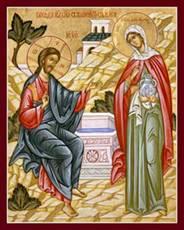
Objectives:
1. Students should be able to tell the story of Jesus and the woman at the well.
2. Students should be able to say the word, “evangelism,” and know that it means telling people about Jesus.
Possible Lesson Plan:
1. Open with prayer.
2. Scripture reference: John 4:1-43.
3. Historical setting: The Samaritans were descendants of the Jewish people who remained in Israel after the rest of the people were carried off into captivity. They intermarried with the people of the land, but continued to worship one God, although not at the Temple in Jerusalem. The Jewish people looked down on them in general as of impure blood.
4. Discussion questions: Who made the well Jesus rested on? Review the story of Jacob and his return from exile in Genesis 33: 18-20. Why was the woman surprised that Jesus would speak to her? What kind of water did Jesus offer the woman? Who did the woman say would tell all things to the people? What was Jesus’s response? What did the woman do? What 2 things caused the people of Samaria to believe that Jesus was the coming Messiah?
This woman's name was Photini. She became one of Jesus's earliest followers and St. Photini spread the gospel throughout her life.
5. Talk a bit about evangelism: What does it mean? Was that what the woman at the well did? Was she excited to tell her friends what Jesus had said? Is there anyone you know who does not know about Jesus? Have you told them? Why or why not?
6. Learning Game: Truth or Consequences. Each student takes a turn standing as player. The teacher should ask a question based on today’s lesson. If the student knows the answer, he can sit down. If he does not know the answer, the rest of the class decides on a “consequence”, subject, of course, to veto by the teacher if there is danger or mess involved. Suggest simple but funny punishments like doing a backwards somersault or standing on the head or rubbing the stomach while patting the head.
7. Add to your time line as usual.
8. Close with prayer. Have each student select someone they know to tell about Jesus this week.
Sermon on the Mount
SERMON ON THE MOUNT
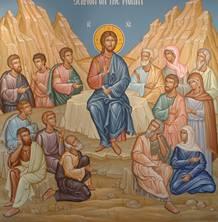 Objectives:
Objectives:
- Students should know that the Sermon on the Mount is full of teachings of Jesus.
- Students should be able to list several important teachings of Jesus: the light of the world, the salt of the earth, the sparrows and lilies, the house on the rock, seek ye first the Kingdom of God, etc.
- Students should memorize and be able to recite the Beatitudes.
Possible Lesson Plan:
- Open with prayer.
- Read the Sermon on the Mount in Matthew, chapters 5-7. All classes are working on the Beatitudes; each of the younger classes is focusing on a particular teaching. By this age, the students should be looking at an overview of the entire sermon. After reading, have students list several famous teachings – light of the world, salt of the earth, lilies and sparrows, houses on rock and sand, seek ye first the kingdom of God, etc.
The Church sees the Beatitudes as steps, each building on the ones before – beginning with humility, without which no further spiritual progress is possible – a ladder of virtues. Indeed, St. John Climacus, in his Ladder of Divine Ascent, often calls on the teachings of the Beatitudes.
- Begin to memorize the Beatitudes. Sing them as we do in liturgy.
- Note that the format of the Beatitudes, “Blessed are the…”, would be familiar to Jesus’s Jewish audience from the Psalms and the rest of the Old Testament. But, Jesus adds new meaning! Discuss the Beatitudes as you recite each one:
- Poor in Spirit: What is humility? How does it compare with the self-centered society we live in?
- Those who mourn: What causes US to mourn? Do we mourn over our sin, separating us from God? Are we drawn closer to God by the times when everything is going well or the times when we are mourning?
- The Meek: Do we have control over the passions, over anger? Are we equally at peace whether praised or dishonored by others? Think of Jesus before the Sanhedrin!
- Hunger and Thirst after Righteousness: Do we seek God and His will with all our heart? Do we fervently seek to find out His will and obey Him, the source of all righteousness?
- Merciful: Do we burn with love for all of God’s creatures, all of our fellow men, reflecting God’s divine love to all?
- Pure in Heart: We cannot produce a pure, or clean, heart by ourselves, but God must work in us. Our part of the job? Repentance!
- Peacemakers: Do we work to bring peace to the lives of those around us?
- Persecution: Jesus promises His followers that, if they follow His teachings, the world will not understand them, will speak evil against them. Are we happy members of the society around us? Or sojourners in a strange land, living the Christian life in a society less and less Christian?
- Discussion: Many of Jesus’s teachings in the Sermon on the Mount have to do with true discipleship – our singleness of purpose in seeking God’s kingdom. “Seek ye first the kingdom of God” comes to mind. How does the salt of the earth fit in? The light of the world? Serving God and Mammon (riches)? House built on the rock? Anxiety about the future? There are many distractions in our search for God’s kingdom. Have the students brainstorm some things they enjoy: TV, McDonalds, football, etc. Honestly consider: if choosing between these activities and going to church, reading the Bible, or saying prayers at home, which would win? Have we really given up all to follow Jesus?
- Play a learning game: “Match the Object”. Fill an egg carton with objects from the Sermon on the Mount – salt shaker, lightbulb, eye, shirt, coin, bread, bird (toy), grass or silk lily, pearl or pearl necklace, fruit, rock, sand – would be examples. Student selects blindly an object and should explain to the class how that object represents a teaching of Jesus in the Sermon on the Mount.
- Add to your time line as usual: Perhaps some of the objects from the “Match the Object” game could be incorporated.
- Close with prayer. Use the Lord’s Prayer, also from the Sermon on the Mount.
Walking on Water and Calming the Storm
WALKING ON WATER AND CALMING OF STORM
Objectives:
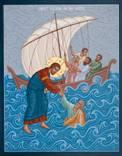 Students should be able to tell the story of the two miracles in their own words.
Students should be able to tell the story of the two miracles in their own words.- Students should be able to identify Peter as the disciple who walked on water.
Possible Lesson Plan:
- Open with prayer.
- Scripture References: Luke 8: 22-25, John 6: 16-21, Matthew 14:24-33, Mark 4: 36-41, 6:47-52. We have here 2 separate miracles, both involving boat trips. Again, make 2 columns on your board: “Calming the storm” and “Walking on Water.” Where were the disciples? What was Jesus doing in each case? What was the weather like? How did the disciples feel? How did Jesus respond? Who came walking across the water? Who wanted to walk with Jesus? What happened when Peter looked down? How did Jesus respond?
- Discussion questions: What do we enjoy about good weather? What are some consequences of bad weather? How do we feel in a storm? Has anyone ever seen a truly bad storm? Can we control the weather today with science? What was Jesus trying to teach his disciples when He stilled the storm? St. Gregory Nazianzus tells us that the ship was carrying Jesus, the God-man, the man weary and asleep but as God stilling the storm. In the stilling of the storm, the prophecies of Habakkuk and Nahum in the Old Testament were fulfilled.
Do we face “stormy times” that have nothing to do with weather? Brainstorm and list some: moving away, failing in school, divorce, arguing with my parents, death getting sick…Now separate these into 2 groups – ones I can change and ones I cannot change. What can we do about the things we cannot change? (prayer) The disciples called on Jesus and He was there. So can we. In fact, in Liturgy we pray in the litany for many things we cannot control. Can you name some? (seasonable weather, peaceful times, travelers by land…, sick and suffering, captives, etc.) Write your own litany using the “stormy times” list for your own prayers. St. Augustine reminds us in these times to awaken the sleeping Christ in us since He is always present with us, ready to help.
- Is it easy to trust God? Peter leaped out of the boat, full of faith – certainly an unusual act, and one none of the others even attempted. While he kept his eyes on Jesus, what happened? His first state of faith and hope were wondrous but then his soul became filled with human reasoning and human methods of preserving his life. When he looked at the water and thought about the danger, what happened? Look again at “Seek ye first the kingdom of God.” Where should our focus be? Is it?
- Play a learning game: Bible Relay. Divide into 2 teams. Line the teams up at one end of the room, with the referee (teacher) at the other. Teacher should have cards with Scripture references on them (e.g., Luke 8:24, Luke 8:25, John 6:18, John 6:20, Mark 4:40, Mark 6:49, Mark 6:51, Matt.14:28, Matt.14:30, Matt.14:31 . The first player in each team should have a Bible. At a shout of “Go”, the first player in each team runs to the referee, is given a card, and must find the reference. He then reads it to the referee and runs back to his team, giving the Bible to the next player.
- Add to your time line as usual.
- Close with prayer, asking God to help us trust Him even in a storm.
Feeding the 5000
FEEDING THE 5000
Objectives:
- Students should identify these as 2 similar miracles of Jesus.
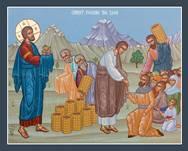
- Students should know the little boy shared 5 loaves and 2 fishes.
- Students should know that Jesus fed 5000 and 4000 men (plus more women and children) after blessing the food.
Possible Lesson Plan:
- Open with prayer.
- Scripture References: Luke 9: 11-17, John 6: 2-14, Mark 6: 32-46, Mark 8:1-9, Matthew 14: 13-23, 15:32-39. There are actually 2 separate but similar stories here. Before reading, write 2 headings on your blackboard or large tablet – “First” and “Second”. After reading, have the students compare and contrast the two miracles and summarize their findings in the two columns. Why were so many people there? They must have been hungry. What did the disciples want to do? What did Jesus feed them? Where did He get the food? What did Jesus do with it? How many were fed? (Note for the students that only men were counted. Why?) What was left over? Was this a miracle? Why or why not? Is there a time in the Old Testament when God miraculously fed His people? (yes, manna in the days of Moses). St. Cyril of Alexandria points out that this is one of the many times Jesus is seen fulfilling in His life the miracles He performed in the Old Testament by the prophets.
- Discuss giving: Did the little boy have to share his food? Why did he share? No one forced him to share his food – he wanted to. Jesus teaches us to share food with others. Do you bring lunch or snack to school? What if someone asks for something especially delicious from you? Will you share? Are there other ways we can share besides food? Brainstorm and write them down. St. Cyril states, “Nor did the miracle end here. There were also gathered twelve baskets of fragments. And what do we infer from this? A plain assurance that hospitality receives a rich recompense from God. The disciples offered five loaves. After a multitude this large had been satisfied, there was gathered for each one of them a basketful of fragments. Let nothing, therefore, prevent willing people from receiving strangers, no matter what there may be likely to blunt the will and readiness of men. Let no one say, ‘I do not possess suitable means. What I can do is altogether trifling and insufficient for many.’ Receive strangers, my beloved. Overcome that reluctance which wins no reward. The Savior will multiply the little you have many times beyond expectation.” (Homily on Luke)
- Play a learning game: Honesty Pays. Divide into 2 teams and line up. Give each player (randomly) a card with a fact about one of the two miracles:
Jesus blessed the food Jesus blessed the food
5000 men 4000 men
5 loaves and 2 fish 7 loaves and some small fish
12 baskets leftovers 7 baskets leftovers
little boy shared
Philip counted the money
Tell the students that their fact may be about the first miracle, the second, or both. But, tell them that Jesus wants them to be honest about their knowledge. The first member of Team 1 reveals his answer. The teacher will ask, “Do you know which miracle your fact belongs to?” If the student answers, “yes”, Team 2 has the right to challenge the student. If they do not challenge, Team 1 gets the point. If they challenge and he knows the fact, Team 1 gets the point. But, if they challenge and he does not know the fact, Team 2 gets the point. If the student answers “no”, Team 2 has the chance to give the correct answer and get the point. Play then passes to the first member of Team 2, with Team 1 having the right to challenge.
- Add to your time line as usual: one or both miracles?
- Close with the Lord’s Prayer: Give us this day our daily bread.
Transfiguration
TRANSFIGURATION
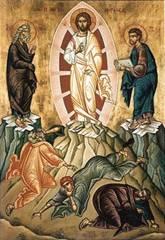
Objectives:
- Students should be able to tell the story of the Transfiguration.
- Students should know that the word “transfiguration” means “change appearance”.
- Students should be able to identify each character in the icon and his role in the story.
- Students should know the date of the feast, August 6.
Possible Lesson Plan:
- Open with prayer.
- Scripture References: Luke 9:28-36, Matthew 17:1-13, Mark 9:1-9. Show the icon. Identify all the characters. What does “transfiguration” mean? Who was transfigured? In what way? Who did Jesus speak to? Which disciples came with Him?
- Songs of the Feast:
Troparion: When Thou, O Christ our God, wast transfigured on the mountain, Thou didst reveal Thy glory to Thy disciples in proportion as they could bear it. Let Thine everlasting Light also enlighten us sinners, through the intercessions of the Theotokos; O Thou Giver of Life, glory to Thee.
Kontakion: Thou wast transfigured on the mount, and thy disciples, in so far as they were able, beheld thy glory, O Christ our God: so that, when they should see thee crucified, they would remember that thy suffering was voluntary, and could declare to all the world that thou art truly the effulgent splendor of the Father.
- Discussion questions:
What preceded the Transfiguration? (Matthew 16:13-end: Jesus asked the disciples who He was? Peter answered. Jesus then told them about His suffering to come and told them that some of them would die before seeing Him in His glory, and a few days later…) In what way was Jesus preparing his disciples for his crucifixion? Why did the disciples forget about the Transfiguration and run away like cowards? Were the disciples chosen because they were such strong and perfect men? Or were they weak and fragile and quite ordinary, just like you and me? So the Troparion recalls their weakness in “as far as they could bear it”.
In Transfiguration, we see Jesus as both God and man. Is he 2 people? Which council settled this issue? (Chalcedon) These are the questions of St. Ephraim: If Jesus were not human, who lay in the manger? If He were not God, whom did the angels glorify? If Jesus were not human, whom did Simeon take in his arms? If Jesus were not God, to whom did Simeon say, “Dismiss me in peace”? If Jesus were not human, whom did John baptize? If Jesus were not God, of whom did the Father speak? If Jesus were not human, who took Peter and James and John to the mount? If Jesus were not God, who spoke with Moses and Elijah?
We also see the Trinity at Transfiguration. At which feast was the triune nature of God (3 persons in 1 God) first revealed? (Theophany) Why doesn’t the Holy Spirit keep the same form on Mt. Tabor (What? luminous cloud) as at the Jordan (What? dove) or at Pentecost (What? tongues of fire)? It would be easier to recognize him if He would. Jesus always appears as a man since the Incarnation. But, the Spirit is not incarnate in the dove or the fire or the cloud; “He is everywhere and fills all things”.
The Transfiguration of our Lord occurred forty days before He was crucified. Remember some other important 40s in the Bible – 40 years in the wilderness for the children of Israel and 40 days in the wilderness being tempted for our Lord? With His Transfiguration, our Lord strengthened the faith of his disciples and helped prepare them for His coming crucifixion. Knowing His divinity, they could understand that His suffering was of His own free will.
- Review the Old Testament stories of Moses and Elijah. Why would God have chosen these two men for Jesus to speak to? What was their importance in the Jewish history? Two very important threads throughout the Old Testament are the Law and the Prophets? Who represents the Law? The Prophets? Also, Jesus was soon to die for the salvation of both the living and the dead. Who represents the living? (Elijah, because he was taken into heaven and never died) Who represents the dead? Both are considered to be forerunners of Jesus. Many people thought that John the Baptist was Elijah come back to life. How was John like Elijah? How was Jesus like Elijah? How was Jesus like Moses? But, even more important, Jesus was clearly greater than these great prophets, not one of them – an important understanding for the disciples.
- The Feast of the Transfiguration is celebrated on August 6. We bring fruit to church on the feast. Why? We are asking God to bless the harvest of fruit and the crops, which are just becoming ripe at this time. Clusters of grapes, ripe in Greece and in Palestine at about the time of the feast, are especially symbolic. What is made from grapes? (wine) Where does our Lord have us use wine each and every Liturgy? (the Eucharist) Why do the Russians bless apples at this time? (the climate is too cold for grapes!)
- Play a learning game: Guessing Game. Divide the class into 2 teams. Each team should have a captain as spokesperson. Both teams listen as the scorekeeper (teacher) reads a description of a character from the lesson (Jesus, Peter, James, John, Moses, Elijah, John the Baptist). Try for a long description, beginning with trivia (This person is a man. He has a beard…) and saving the critical facts for the end. The captain should stand when his team knows who it is. If right, that team gets the point.
- Add to your time line as usual.
- Close with prayer. Ask God to bless the fruit and crops now and every year.
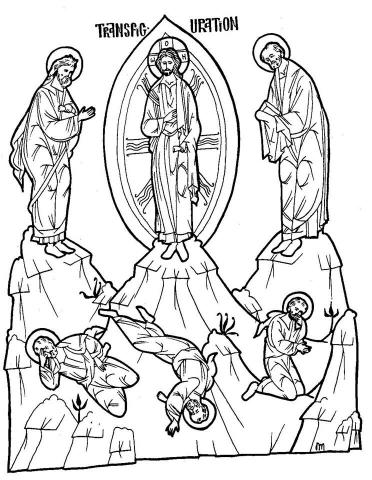
Good Samaritan
THE GOOD SAMARITAN
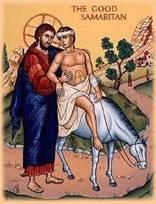
Objectives:
- Students should be able to identify this story as a parable of Jesus.
- Students should be able to tell the story in their own words.
- Students should have an understanding of what makes a good neighbor.
Possible Lesson Plan:
- Open with prayer. Use the Lord’s Prayer.
- Scripture Reference: Luke 10:25-37. Review the meaning of a parable, a story with a hidden meaning. Jesus told this story to answer a question – what was the question? Who asked it and why? Where did the merchant come from; where was he going? What happened to the man in the story? How many people passed by? Why did they pass by? Why did the Samaritan stop? What did he do? Was the Samaritan man a good neighbor to the hurt man? Why?
- Discuss the concept of “neighbor”: Ask the students who are their neighbors. After a listing of friends and neighbors, try to expand their focus. Is the homeless man in the street who smells bad and is dirty also a neighbor? Have you ever “passed by”? Is the child who steals their lunch money also a neighbor? Is the boy who hits them on the playground also a neighbor? Did Jewish people usually like Samaritans? Did Samaritans usually like Jewish people? Remind the children that the Samaritans were the descendants of the people who were not taken into Babylon in captivity; they married people of the land and were hated by the Jews when they returned. Was it easy for this Samaritan man to care for the Jewish man? Is it always easy to love other people and to do good things for them? Is there someone you find particularly difficult to love? Can you do something nice for them as a good neighbor? Metropolitan Anthony of Sourozh sums it up this way: “We have spent a whole morning in God's own presence, in the place where He lives; we have heard His voice speaking to us about love…And we are going to leave this church; we will meet more than one person in the course of the coming week or until at a later date we come again to church. Are we going to be like the priest or the Levite? Pondering on what we have learned here, keeping in our hearts the wonder and the joy, but passing by everyone because to care for things lesser might disturb our peace, take our mind and heart away from this sense of the marvel of having seen God, of having been in His presence? If we do this, then we have understood little, if anything, of the Gospel, of Christ, of God. And if we ask like the young man, or the lawyer, “But who is my neighbor?” Who is he for whose sake I must be prepared to let go of the deepest feelings of my heart, of the most lofty concern of my mind, of the best I feel within me? - the answer of Christ is direct and simple: anyone! Anyone who is in need of you on any possible level; on the simplest level of food or shelter, of gentleness and kindness, of thoughtfulness and friendliness.”
- Play a learning game: Pass the Ball. Sit in a circle. The leader holds a small ball. He begins the story of the Good Samaritan with one line and passes the ball to the next player. This person must continue the story with one line. And so around the circle as many times as needed to finish the story.
- When did Jesus tell this story? Add to your time line as usual: one scene or many comic-strip fashion?
- Close with prayer. Have each student think of a particular person who is hard to love and pray for that person and plan something nice for that person.
Parable of the Sower
PARABLE OF THE SOWER
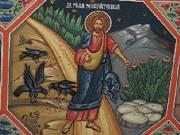
Objectives:
- Students should be able to tell the story of the parable in their own words.
- Students should know the word, “parable”, and be able to say that it is a story with a hidden meaning.
- Students should know the “hidden meaning” of the seeds and the sower.
Possible Lesson Plan:
- Open with prayer.
- Scripture References: Mark 4:1-20 and Luke 8:5-15. What is a parable? In this parable, who is the sower? What are the seeds? What is the soil?
- Try to understand the parable a bit: What kind of people are hard, rocky ground? Would seeds grow well there? What kind of people are easily dried out by the hot sun? Would seeds grow well there? What kind of people are so shallow the birds can eat the seeds? What kind of things might be thorns that take over our lives? What kind of people are rich soil? What kind of people are each of us? Are we different types of soil at different times in our lives?
Metropolitan Anthony of Sourozh tells us that each of us is at different times each of these people. “What about us, receiving the message and bearing fruit? But how does this message reach us? I remember a Russian priest saying to me, I read the Gospel daily, and I respond to it very seldom. But I read it daily because I never know whether today, or tomorrow, or on another day I will be the barren roadside, or the weeds by the way, or, of a sudden, whether this word will not fall on a small patch in me which is capable of receiving it and bearing fruit. Isn't that simple, isn't that encouraging? We all are the three things described in the parable of the Gospel; but if we give a chance to God Who speaks, to God, Who passes through our life, to God Who knocks at our heart - from time to time we will receive the message with joy and let go of it; but from time to time it will reach a depth in our heart, a core of our life and be the answer that will change it.” When was the last time in your life the Word of God touched you so deeply?
- Play a learning game: “A Missing Part”. Select enough verses from the story in either Mark or Luke that every pair of students will have a verse. Write each verse on a piece of paper. Tear the paper in half. Give each student a half sheet. Students must find the student with the other half of the verse. They then sit down together. When all are seated, have each pair read the entire verse; this can be really funny if each student reads only from his half!
- When did Jesus tell this one? Add to your time line as usual.
- Close with prayer, asking Jesus to make us good soil to learn and obey His teachings.
Zaccheus
ZACCHEUS
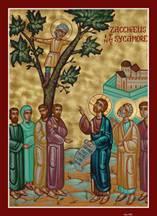
Objectives:
- Students should be able to identify Zaccheus as the short man who wanted to see Jesus.
- Students should know that Zaccheus’s life was changed by meeting Jesus.
Possible Lesson Plan:
- Open with prayer.
- Scripture Reference: Luke 19:1-10. What did Zaccheus do for a living? Do we know another tax collector in the Bible? (Matthew, the disciple) Why couldn’t Zaccheus see Jesus? What did he do? What did Jesus say to Zaccheus? What did Zaccheus do for Jesus?
3. Discussion: Jesus was a famous man; people from all over came to see Him. Why? Have students list several reasons why people would want to see Jesus. (to be healed, to hear His teachings, to see a miracle, just to say they saw Him) Indeed, the blind man was healed in the gospel just before the Lord met Zaccheus. What did Jesus ask the blind man? “What do you want me to do for you?” (Luke 18:41). What do WE want from Jesus? Zaccheus lived in Jericho, the City of Palms. Find Jericho on your maps. He heard that Jesus would be coming to town. Zaccheus was rich; he was the chief tax collector. Remember that tax collectors collected exorbitant taxes and kept the extra. Was Zaccheus popular? Do you think he had many friends? Make 2 columns on your board: “Things money can buy” and “Things money can’t buy.” Brainstorm to fill the lists. Zaccheus could have all he wanted in the first column. What about the second? Do we sometimes think that we’d be happy if only we had everything that money could buy? Was Zaccheus a happy man? Why do you think Zaccheus wanted to see Jesus? How did Jesus respond? How did Zaccheus’s visit with Jesus change him? We meet the rich young ruler also in Luke 18, unwilling to give of his riches and to follow Jesus. Jesus comments on how difficult it is for a rich man to enter the kingdom of heaven. Here He shows us that with God truly all things are possible – look at Zaccheus and his response to meeting Jesus! In the end, Zaccheus uses his riches for good, giving half to the poor and returning the other half fourfold to the people he had cheated. How are we using OUR riches?
- Metropolitan Anthony of Sourozh sees another aspect of this gospel lesson. Zaccheus did something very unusual that day for a man of his social and political standing – he climbed a tree. “Zacchaeus might not have done it any more than very often we don’t do it, for the same reason: he might have been too proud, too vain, he might have counted on his own abilities, he might have thought, as many did and do and will do, that they do not need the humble help which is offered them, because they can reach soaring to the heights. Zacchaeus yet was not defeated by vanity, by pride, because something had gone on in him as we can see at the end of this reading, making it absolutely imperative for him, of necessity to meet Christ. He was ripe and at that moment, as everyone knows when this moment comes - we are prepared to face not only criticism and hatred and opposition, we are prepared to face even the ridicule of becoming like none around us, to behave in a way that is strange to our normal surroundings. This person had the position of what we should call nowadays a bank manager and yet he was not afraid or ashamed of all the fun he was giving to the crowd because he was prepared to go beyond that. It mattered too much to him to meet Christ to worry about what those, who had not reached his stage of ripe anguish for eternity, would think. And Christ saw him alone in the crowd because he alone had overcome vanity and pride in order to meet Him. The reason why he had we can see in the last words of the Gospel, in his readiness to put all his life right in order to be worthy of the Guest who now entered his house.” Are we, like the crowd, too afraid of looking ridiculous to seek the Lord, or, will we, like Zaccheus, do anything, anything He asks of us, to meet Jesus?
- Play a learning game: Musical Bridge. This is played as a cross between musical chairs and London Bridge. The teacher and one student form the bridge. The rest line up and circle while singing “Zaccheus was a wee little man…” Whoever the bridge catches at the end of the song must answer a question about Zaccheus. If he answers correctly, he gets to become part of the bridge. Sample questions might be:
What did Zaccheus do for a living? What did Jesus say to Zaccheus?
Where did Zaccheus live? Where did Jesus have supper?
Was Zaccheus tall or short? How much did Zaccheus give
What kind of tree did Zaccheus climb? to the poor?
- Add to your time line as usual. What does a sycamore tree look like?
- Close with prayer.
Publican and Pharisee
THE PUBLICAN AND THE PHARISEE
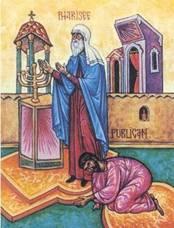 Objectives:
Objectives:
- Students should be able to define “publican” and “Pharisee”.
- Students should know whose prayers God listened to and why.
- Students should note the similarity between the prayer of the publican and the Jesus Prayer, which we pray today.
Possible Lesson Plan:
- Open with prayer.
- Talk a bit about humility: How do you feel when you win a race? Get a prize? Do something good? This feeling is called pride. Some pride is OK. But the Pharisee had done many good things – so many good things that he was always bragging about himself, even to God! Do you ever brag when you do something good? How does it make you feel? How does it make other people feel? Do you feel like you’re better than other people? Does it look that way when you brag? Did the Pharisee think he was better than the publican? Was he in God’s eyes? Have you ever done anything wrong – ever disobeyed God or your parents, cheated in school, hit your brother, yelled at your sister, etc.? None of us is perfect; we all make mistakes. When we pray, should we brag, or should we ask God to help us obey Him even better? Remember the Beatitudes: can anyone recite “Blessed are the poor in spirit…” Which was poor in spirit – the publican or the Pharisee? Which will inherit the kingdom of heaven? The prayer of the publican, felt deep within his heart, and full of the awareness of the greatness of God and his own unworthiness, went straight to heaven; the prayer of the Pharisee certainly went to the ears of those around him! Which left the temple justified?
- Scripture Reference: Luke 18:9-14. What is a publican? Who else have we met who is a tax collector? (Zaccheus and Matthew) Review their stories briefly. What did the publican pray? What is a Pharisee? (a respected man of the temple) What did he pray? Which did God listen to? Why?
- Remind the students of the Jesus Prayer, used by Orthodox Christians today: “Lord Jesus Christ, Son of God, have mercy on me, a sinner.” St. Ignatius (Brianchaninov) states that in this prayer, commended by the Lord Himself, “He later allowed and granted us to pray using His all-holy name…in the New Testament, an expansive completion to the old prayer was presented to man – a new way of praying to the intercessor through Whom the Godhead is united with mankind.” So, when we’re praying the Jesus Prayer, remember the prayer of the publican – completed and even more precious. Review with the students the Jesus Prayer, and be sure each can say it.
- Play a learning game: Publican Says. Line the students up along the wall. Tell them that they will hear a line of a possible prayer, followed by a command. If the prayer would have been that of the publican, they should follow the command, just like in “Simon Says”. But if it’s the Pharisee’s line, they should not follow the command. Of course, just as in Simon Says, the student is “out” if he does the wrong thing. Sample lines (mix them up):
Pharisee: God I thank thee that I am not like other people; touch your toe
I fast twice a week; rub your nose.
I pay tithes of all I get; shake your head.
I am a wonderful man; stand on one foot.
Publican: God be merciful to me; touch your eye.
I am a sinner; rub your stomach.
I am not worthy to be called your son; touch your elbow.
I cannot even lift my eyes to heaven; wave your hand.
- Add to your time line as usual.
- Close with prayer. Use the Jesus Prayer, and suggest that the students focus on this prayer during their own prayer time this week.
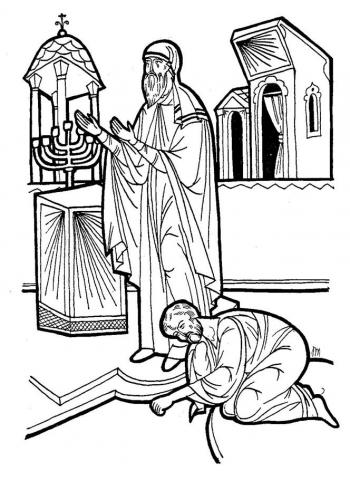
Prodigal Son
THE PRODIGAL SON
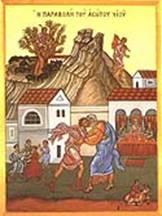
Objectives:
- Students should be able to tell the story of the Prodigal Son.
- Students should know that God’s nature is to forgive.
Possible Lesson Plan:
- Open with prayer.
- Scripture Reference: Luke 15:11-32. Where did the son go? What did he do with his money? Did the spending of money, rich food, parties – did these make him happy and fulfilled? Where did he end up, doing what? Why did he go back to his father? What did he say? What did his father say? How does this apply to our lives? How do we use our money, our talents – all of the things given to us by our heavenly Father? We are made to dwell in His house. Are we happy and fulfilled when living far away from the God who made us in His image?
- Discussion: Let’s look a bit at the older brother. He stayed at home, obedient. He had the fulfilling life, in the love of his family. Where was he when the younger brother returned? What did he hear as he approached the house? How did he feel about all the celebration? Why? What did the father do when the older brother wouldn’t come to the party? What did the father say? How did the brother respond? Read another parable in Matthew 20:1-15. Every year at Pascha we hear St. John Chrysostom’s sermon about this parable. Compare the older brother with the first workers. Why do we feel slighted when the Lord is generous and forgiving to someone else?
- Play a learning game: Word Jumble. Give each student a pad and pencil. Have your chalkboard or large tablet ready. Ask the question and then write the scrambled answer on the board. Give the students 30-60 seconds to write their answer on their tablet and go on to the next question:
(1) I was supposed to be given away when the THENECIARNI
father died. What am I?
(2) I left my family to go to the city. Who am I? GRAPOLID SNO
(3) I am a shortage of food. What am I? MEFNIA
(4) I gave the prodigal son a job. Who am I? GPI NOREW
(5) I was given to the prodigal son when he GIRN
returned. What am I?
(6) I forgave the prodigal son. Who am I? SHE TREAFH
(7) I did not waste my inheritance. Who am I? DOREL OSN
(8) I was called on to prepare a feast. Who am I? NEVSTAR
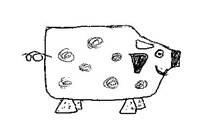 Make a Piggy Bank: Take a gallon milk or juice plastic container. Turn it on its side so the handle is on top. Glue eyes just below the handle on both sides, 4 corks or bottle tops for feet, pink felt ears, and paper circles for spots all over the pig’s body. Twist a pipe-cleaner into a tail and poke it into the plastic behind. Draw on a mouth. Finally, cut a slit in the top for coins. All during Great Lent, we will each collect coins at home (from the sofa cushions, off the floor, by doing chores, etc.) and will bring them in to class to put in the class Piggy Bank to give to the IOCC at Pascha.
Make a Piggy Bank: Take a gallon milk or juice plastic container. Turn it on its side so the handle is on top. Glue eyes just below the handle on both sides, 4 corks or bottle tops for feet, pink felt ears, and paper circles for spots all over the pig’s body. Twist a pipe-cleaner into a tail and poke it into the plastic behind. Draw on a mouth. Finally, cut a slit in the top for coins. All during Great Lent, we will each collect coins at home (from the sofa cushions, off the floor, by doing chores, etc.) and will bring them in to class to put in the class Piggy Bank to give to the IOCC at Pascha.- Add to your time line as usual. Can you incorporate the pigs in some creative way?
- Close with prayer. Can you sing: I shall arise and go unto my Father and shall say unto him, “Father, I have sinned against heaven and before thee and am no more worthy to be called thy son.” In a round?
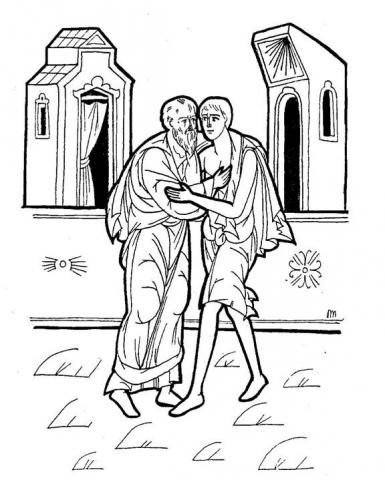
Last Judgment
THE LAST JUDGMENT
Objectives:
- Students should know that Jesus is coming again as judge.
- Students should be able to list some of the characteristics of goodness.
Possible Lesson Plan:
- Open with prayer.
- Scripture Reference: Matthew 25: 31-46. Have students list characteristics of the sheep as headings on the board – e.g. food, drink, invitation, visit the sick, prisoners.
- On this day, we remember that, Jesus came to earth as a humble child and lived among us, but He will come again in his Second Coming as the Judge. When will this occur? Jesus tells us that no one will know…we are to “be prepared” at all times. Those who have done well will be welcomed into eternal paradise, and those who have done evil to eternal hell. Scary, right? St. John Climacus says, “If an earthly king were to call us and request us to serve in his presence, we should not delay for other orders, we should not make excuses, but we should leave everything and eagerly go to him. Let us then be on the alert, lest when the King of kings and Lord of lords and God of gods calls us to this Heavenly office, we beg off out of sloth and cowardice and find ourselves without excuse at the Last Judgment.” And what service does our King ask of us? The ones given in this verse -- where is the mention of how many times I fasted, or how many times I prayed, or how many times I sang in church? Nowhere! No special gifts are required to be a sheep instead of a goat – the qualities of a sheep are ones we can all show in our daily lives.
- Historical review: Review some Old Testament stories of judgment: Adam and Eve and the Garden, Noah and the flood, Sodom and Gomorrah and Lot’s wife, Pharaoh and the plagues of Egypt, etc.
- Read the Poem, “The Guest,” by Edwin Markham:
Before the Cathedral in grandeur rose,
At Ingelburg where the Danube goes;
Before its forest of silver spires
Went airily up to the clouds and fires;
Before the oak had ready a beam,
While yet the arch was stone and dream –
There where the altar was later laid,
Conrad, the cobbler, plied his trade.
Doubled all day on his busy bench,
Hard at his cobbling for master and hench,
He pounded away at a brisk rat-tat,
Shearing and shaping with pull and pat,
Hide well hammered and pegs sent home,
Till the shoe was fit for the Prince of Rome.
And he sang as the threads went to and fro:
“Whether ‘tis hidden or whether it show,
Let the work be sound, for the Lord will know.”
It happened one day at the year’s white end,
Two neighbors called on their old-time friend;
And they found the shop, so meager and mean,
Made gay with a hundred boughs of green.
Conrad was stitching with face ashine,
But suddenly stopped as he twitched a twine:
“Old friends, good news! At dawn today,
As the cocks were scaring the night away,
The Lord appeared in a dream to me,
And said, ‘I am coming your Guest to be!’
So I’ve been busy with feet astir,
Strewing the floor with branches of fir.
The wall is washed and the shelf is shined,
And over the rafter the holly twined.
He comes today, and the table is spread
With milk and honey and wheaten bread.”
His friends went home; and his face grew still
As he watched for the shadow across the sill.
He lived all the moments o’er and o’er,
When the Lord should enter the lowly door –
The knock, the call, the latch pulled up,
The lighted face, the offered cup.
He would wash the feet where the spikes had been;
He would kiss the hands where the nails went in;
And then at the last would sit with Him
And break the bread as the day grew dim.
While the cobbler mused, there passed his pane
A beggar drenched by the driving rain.
He called him in from the stony street
And gave him shoes for his bruised feet.
The beggar went and there came a crone,
Her face with wrinkles of sorrow sown.
A bundle of sticks bowed her back,
And she was spent with the wrench and rack.
He gave her his loaf and steadied her load
As she took her way on the weary road.
Then to his door came a little child,
Lost and afraid in the world so wild,
In the big, dark world. Catching it up,
He gave it the milk in the waiting cup,
And led it home to its mother’s arms,
Out of the reach of the world’s alarms.
The day went down in the crimson west
And with it the hope of the blessed Guest,
And Conrad sighed as the world turned gray:
“Why is it, Lord, that your feet delay?
Did You forget that this was the day?”
Then soft in the silence a Voice he heard:
“Lift up your heart, for I kept my word.
Three times I came to your friendly door;
Three times my shadow was on your floor.
I was the beggar with bruised feet;
I was the woman you gave to eat;
I was the child on the homeless street!”
- Discussion: Begin with your headings under sheep on the board. Make columns under each heading and brainstorm for specific ways that we can personally fulfill that characteristic. For example: under food – homeless bags, under clothing – give to Goodwill. Be sure there are several choices for each heading – actions that are feasible for this age group. Then, have the students commit to doing one of these things each day during Great Lent. Pass out copies of calendars as Lenten diaries to write down the action on each day.
- Play a learning game: Finish the Verse. Print the first and last halves of each verse on separate cards. For example:
I was hungry You gave Me something to eat.
I was thirsty You gave Me drink
I was a stranger You invited Me in
I was naked You clothed Me
I was in prison You came to Me
Give each student a card. At “Go”, each must find his other half. The pair then sit down together. When all are paired, have each team read the entire verse.
- Add to your time line as usual. Focus on the activities or on heaven or on sheep and goats?
- Close with prayer. Pray specifically for your plans to fulfill during Great Lent.
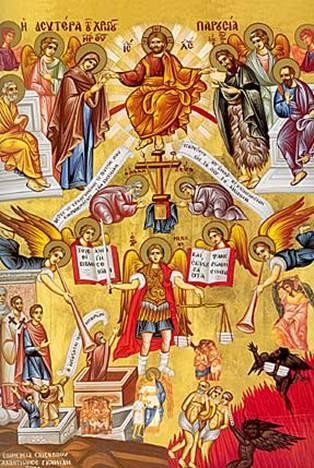
F
Forgiveness and the Paralytic
FORGIVENESS/ THE PARALYTIC
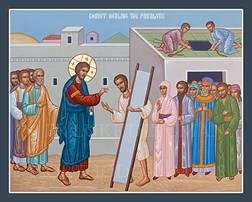 Objectives:
Objectives:
- Students should be able to tell the story of the paralytic and his four friends.
- Students should know that Jesus can forgive sins because He is God.
- Students should know that we receive forgiveness from God through Confession and from each other on Forgiveness Sunday.
Possible Lesson Plan:
- Open with prayer.
- Scripture References: Luke 5: 17-26, Matthew 9:1-8, Mark 2:1-12. What does “paralytic” mean? Where was Jesus? Where were the friends with the man? How did they get into the house? What did Jesus do? Say? What happened? How do you think the man felt? His friends?
- Who forgives sins? Jesus said something unusual to the paralytic before he healed him. What did He say? The paralytic hoped for healing for his body. But Jesus first healed his soul. The Prodigal Son asked for forgiveness; did the paralytic? Tonight, in church, we’ll be celebrating Forgiveness Sunday. We’ll go from one to another asking forgiveness and being forgiven. But, only one person can forgive us all our sins. Who is that? When Jesus told the paralytic that his sins were forgiven, Jesus was claiming to be Whom? And, when the paralytic walked, Jesus proved that He was indeed God!
Through which of our Sacraments do we receive forgiveness from God?
(Confession) Why can’t we just confess in secret to God? (What about that pervasive self-deceiving psychological trick, denial, and accountability?) Who does the priest represent? (Christ) Did Jesus have the authority to forgive sin? (Consider the healing of the paralytic) What was the practice of the earliest Christians? (They actually stood up before the whole congregation and confessed their sins, truly walking in the light.) Why did this practice end and priests begin to hear confession privately? (Strangers coming to visit as the Church grew in numbers made public confession difficult.)
- Play a learning game: Charades. Write the names of several miracles we have already studied on slips of paper – Feeding the 5000, walking on water, quieting the storm, water into wine, paralytic, transfiguration. Each student in turn should choose a paper and act out the miracle so the others can guess what it is.
- Add to your time line as usual.
- Close with prayer.
Miracles and Healings
MIRACLES AND HEALINGS
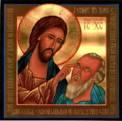
Objectives:
- Students should be able to tell the story of at least one healing of Jesus.
- Students should know the word “miracle” and what it means.
- Students should know that we access the healing power of Jesus through the Sacrament of Holy Unction.
Possible Lesson Plan:
- Open with prayer.
- Scripture References: Assign a Scripture or two to each student, to read and report to the class:
Mark 5:22-24, 35-43 Mark 3:1-5
Luke 7:2-10 John 9:6-9, 24-25
Mark 7:32-37 Luke 13:11-13
Mark 1:30-31 John 4:46-53
Luke 17:12-19 Luke 22:50-51
Mark 9:17-29 Mark 10:46-52
Mark 8:22-26 John 5:5-15
What kinds of problems did Jesus heal? What kinds of people did Jesus heal? Did He heal the same way each time? Did Jesus heal only the Jewish people or was He sent to all people? (The first Gentile healed was the servant of the Roman Centurion.)
- Discussion: The Church has a special sacrament where we pray for healing. It is called “Holy Unction.” Can Jesus really heal the sick? Are there miracles today? Didn’t Jesus have to touch the person to heal him? (No, remember the Roman centurion’s servant) Aren’t miracles really superstition? How does the sacrament of Holy Unction differ from say a rain dance by the pagans? Don’t we have doctors now we can go to if we are sick? Why doesn’t Jesus heal everyone? Why do we get sick at all? Aren’t we all going to die anyway? Should we only call for Holy Unction when we are dying? (no) In what other ways can we as Christians serve those who are ill, especially those who are chronically ill?
- Play a learning game: Bible Headlines. Assign a miracle to each student. Have the students come up with a catchy headline for their miracle. After a few minutes, have the students one by one present their headline. Can the others guess the miracle?
- Add to your time line as usual – several of today’s miracles, or one especially wonderful one? Check the “dates” of the events to include on the time line. Save a bit of space also for parables we’ll study at the very end.
- Close with prayer, praying especially for anyone known by a student to be sick.
Lazarus
THE RAISING OF LAZARUS

Objectives:
- Students should be able to tell the story of Lazarus in their own words.
- Students should know the names of Mary, Martha, and Lazarus.
Possible Lesson Plan:
- Open with prayer.
- Scripture Reference: John 11. Where was Jesus when Lazarus became sick? Who were the sisters of Lazarus? How was Lazarus by the time Jesus came? What did Jesus do? Why did Jesus cry? What happened to Lazarus after Jesus prayed? Review the story with the icon, identifying Jesus, Lazarus, Peter, and the sister.
- Reporters for the Bethany Times: Pretend that the students in the class are reporters for the Bethany Times. We’ve all seen it done on TV -- a microphone stuck in someone’s face and questions, some reasonable, some silly, asked. Each student interviews a different person in preparation for writing a story on what has to be one of the biggest events in recent history. Some of the interviewees are eyewitnesses; some are being interviewed as to what they think because of their high position. Spend a few minutes rereading John 11 in the eyes of one person – Lazarus, Mary, Martha, unidentified mourning neighbor, Peter, Simon the Zealot, Judas Iscariot, high priest, or Pontius Pilate (governor). Present the quite varied accounts to the entire class as editor. What should the headline read?
- Discussion: Was this the first person Jesus raised from the dead? (No, the son of the widow of Nain and the daughter of Jairus, but both had just died; they had not been dead for 4 days) Why is the 4 days important; why did Lazarus “already smell”? (The 4 days show true corruption, the rottenness inside us all, defeated by Jesus in the tomb, since He alone is without corruption or sin) Who did Jesus say that He was to Martha? (I am the resurrection…) What’s the shortest verse in the Bible? (piece of trivia, “Jesus wept.”) Why did Jesus weep? (because God truly cares, He is the Lover of Mankind)
- Play a learning game: The Big Step. Players line up along one wall. The opposite wall is the finish line. Teacher asks each player a question about today’s lesson in turn. If the player gives the correct answer, he can advance one giant step toward the goal. If not, next player gets a chance with the same question. First player to the opposite wall is the winner.
- Add to your time line as usual.
- Begin your Lenten Journey Calendar, adapted for Orthodoxy from the Catholic Icing website. Print on cardstock for each student and color in or mark off the days already past. Then take home and begin the countdown to Holy Week and Pascha.
- Close with prayer.
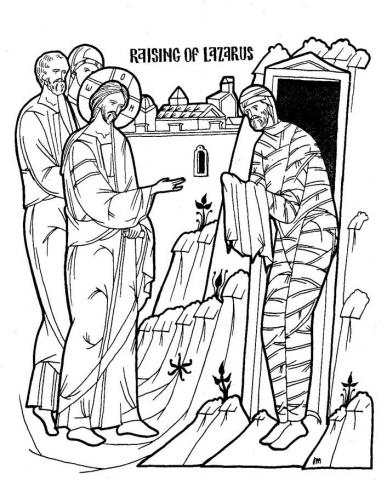
Palm Sunday
PALM SUNDAY
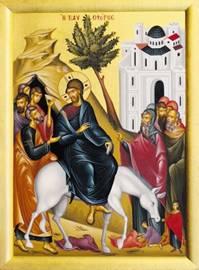 Objectives:
Objectives:
- Students should be able to identify the characters and the action in the icon.
- Students should know why we use palms on Palm Sunday.
- Students should know that Palm Sunday is the day after Lazarus Saturday and the week before Pascha. Why?
Possible Lesson Plan:
- Open with prayer.
- The icon: What do the students already know? Christ the central figure, seated on a donkey (Why a donkey?), the disciples on the far left and the Jews on the far right, the children (one in a tree cutting palm branches and one spreading his cloak under Christ), the city of Jerusalem with the Temple with its onion dome.
- Scripture readings: Matthew 21:1-11, 15-17, John 12:1-18
- Songs of the Feast:
Troparion: By raising Lazarus from the dead before thy passion, thou didst confirm the universal resurrection, O Christ God. Like the children with the palms of victory, we cry out to thee, O Vanquisher of death: Hosanna in the highest, Blessed is He that comes in the name of the Lord.
- Discussion questions:
How did the resurrection of Lazarus effect the response of the crowd on Palm Sunday? Explain the Troparion in your own words; the same Troparion is used for Lazarus Saturday and Palm Sunday, why? What did Jesus show the world? (that God’s power is greater than death) Did Jesus enter Jerusalem on a warhorse surrounded with an army? Why not? (He came to bring His love, coming on a peaceful donkey) What was the significance of the donkey? Whose prophecy was being fulfilled? (Zechariah) How’d he get the donkey? St. Ephraim the Syrian compares the riding of the donkey on Palm Sunday to the Nativity and the manger, feeding trough of donkeys. Can you?
What does “Hosanna” mean? (“I ask you to save me”) Where did the greeting the people gave Jesus on Palm Sunday come from? (Psalm 118: 25-26) Thus Jesus is being recognized as King. What is the significance of the greeting, “Son of David”? (Jesus is recognized as Messiah.) Did Jesus sneak into the city, afraid of its leaders since He knew what they would do to him only a few days later? What would you have done in that situation? Does the raising of Lazarus and the triumphal entry into Jerusalem have any effect on the priests who will later condemn Jesus? (It is because of these and the response of the people, that He was judged and condemned.) What is the significance on Palm Sunday of Jesus’s reddish garments? (From Genesis 49: represent blood) Remember that with our palms of joy we are also called to suffering and death; we cannot have the one without the other!
- How does our Church celebrate Palm Sunday? (procession, palms, pussy willows) What is the significance of these customs?
- Play a learning game: Final Jeopardy. Give each student a pad of paper and a pencil. Prepare your “answers” ahead of time – e.g. donkey, Hosanna, Jerusalem, Lazarus, etc. Give the answer and each student should write an appropriate question on his pad. After 30 seconds, hold up the questions and compare.
- Add to your time line as usual. Things will be getting a bit crowded for the next “week” in the life of Jesus.
7. Close with prayer.
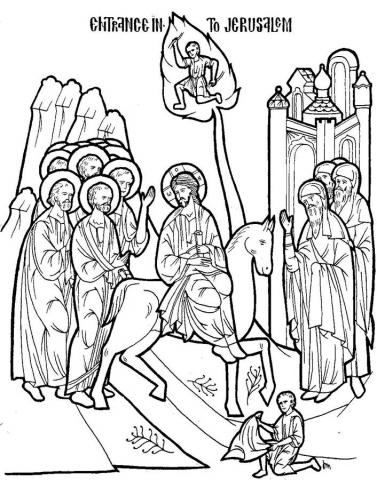
Last Supper
THE LAST SUPPER
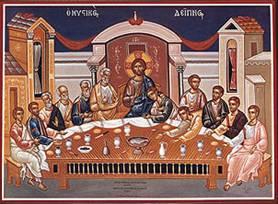
Objectives:
- Students should be able to tell the story of the Last Supper in their own words.
- Students should identify the major figures in the icon.
- Students should know that the Last Supper was also the first Communion.
Possible Lesson Plan:
- Open with prayer.
- Scripture References: Matthew 26: 17-75, Mark 14:12-72, Luke 22:1-65, John 13 and 18:1-27. Each gospel writer, just like the witnesses the class interviewed during the lesson on Lazarus, wrote what he (or his source) observed. Divide the class into 4 groups and have each group spend about 5 minutes reading one of the gospels above. Then, make a timeline on the board. Beginning with Matthew, have each group fill in the events recorded in its reading to get a complete view of this important event. Then, review the story with the icon, identifying the characters, the bread, and the wine. We celebrate the Last Supper on Holy Thursday with the 12 readings of the story.
- Historical background: Review the story of Passover in Exodus 12:1-13. Jesus and His disciples were celebrating Passover dinner in accordance with the Law of Moses at the time of the Last Supper. In fact, Jesus is called the Paschal lamb. How is He like the Passover lamb? The lamb saved God’s people from death, just as Jesus was soon to save all people from death.
- Discussion: At the Last Supper, Jesus instituted the Sacrament of the Eucharist. Why do we celebrate the Eucharist? Are they truly His body and blood or only a symbol? How do they become His body and blood? (a mystery!) What can happen if they are taken unworthily?
- Play a learning game: 20 Questions. Write the names of the significant people from today’s lesson on small slips of paper – Jesus, Peter, John, Judas, man with jar, Moses, Pharaoh, Caiaphas, high priest’s slave, servant girl at the fire, rooster. Each student in turn can select a paper. The others must identify the character by asking yes or no questions.
- Add to your time line as usual. Both this lesson and next week’s cover the multitude of events of Holy Week. How will you depict them? As a collage?
- Close with prayer.
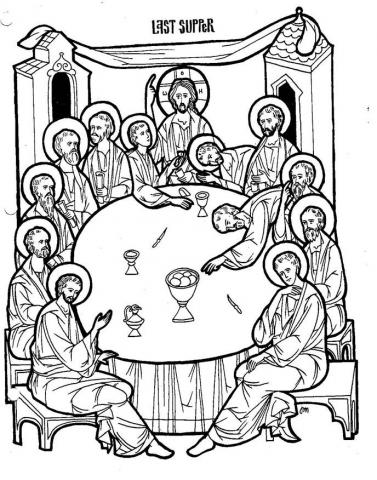
Crucifixion
THE CRUCIFIXION
Objectives:
- Students should know the story of Jesus’s arrest, trial, crucifixion, and burial and be able to tell it in their own words.
- Students should be able to identify the characters in the icon and their meaning.
- Why is the cross the universal symbol of Christianity?
Possible Lesson Plan:
Open with prayer.
Scripture References: Matthew 27, Mark 15, Luke 23, John 18-19. Again, divide into 4 groups, each reading one gospel. Report to the rest of the group. Draw a large time-line on the board and fill in the events of Holy Friday. Where was Jesus when He was arrested? What was He doing? What were the disciples doing? How did Judas betray Him? Peter lied about knowing Jesus how many times? Before when? Who was the high priest? The soldiers put what on Jesus? Who condemned Jesus to death? How did He die? Who carried the cross? Why? What are some of the things Jesus said on the cross before He died? Who was crucified with Jesus? What happened when Jesus died? Who took Jesus’s body to his own tomb? Review the story with the icon, identifying the people. What role did each play?
- We celebrate the Crucifixion on Holy Friday. We sing on Thursday about the “Wise Thief”. Which thief was wise and why? We also sing on Friday about “The Noble Joseph”. Who was the noble Joseph? What did he do? Play these beautiful songs if you want with tape or CD from the bookstore. Do you remember what we do in Church on Holy Friday? (Procession, candles, the tomb.)
- Review the major players: Jesus, the 12 disciples (who were they?), myrrh-bearing women (though they haven’t brought the myrrh year, who will they be?), the Pharisees (a group of religious leaders of the Jews particularly devoted to the Torah), the Sadducees (a wealthy priestly aristocracy, concerned with Temple administration and ritual), the scribes (educated civil servants), the Sanhedrin (a senate of 70 priests and laymen, presided over by the high priest), Caiaphas the High Priest, Pontius Pilate the Roman governor, Herod the King, Barabbas the condemned murderer, the 2 thieves, the centurion (the same one who had early sough Jesus out for healing of his servant according to tradition), and Joseph of Arimathea (a wealthy follower of Jesus and member of the Sanhedrin, “the noble Joseph”).
- Play a learning game: Make a Holy Week gameboard. Draw a standard gameboard shape and mark off about 75 spaces between start and finish. Include on some of the spaces events of Holy Week, with penalty or reward, depending on type of event – e.g., Enter Jerusalem in Triumph, go forward 5 spaces, or Betrayed by Judas, go back 3 spaces. One trick – be sure the space to which the player is directed is blank, or he’ll be jumping all over the board. Each player uses a small marker (coin, etc.) and moves the number of spaces tossed by the dice. If no dice? Write 1,2,3,4,5, and 6 on slips of paper and draw one! The design of the game is the most important; if there’s no time to play, perhaps the teacher can duplicate the game for each student and give them out next week for play at home.
- Add to your time line as usual. Again, lots of events. Try to coordinate with last week’s entry.
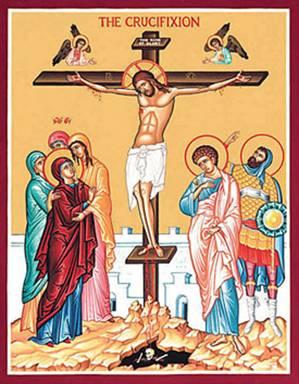 Close with prayer. Sing together “Before Thy Cross”.
Close with prayer. Sing together “Before Thy Cross”.
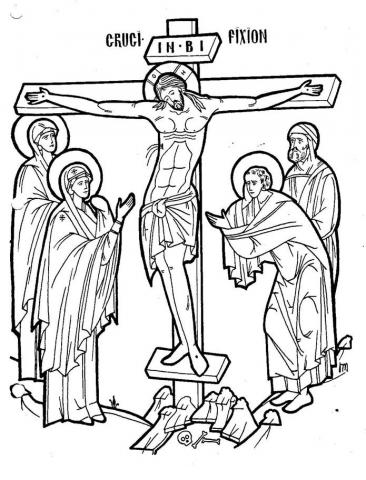
Pascha
PASCHA, THE FEAST OF FEASTS
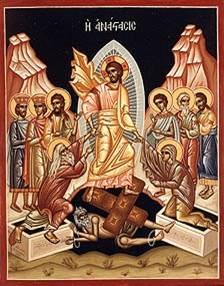 Objectives:
Objectives:
- Students should understand the icon, its characters and its significance.
- Students should know the Troparion of the feast and “Christ is risen…”
- Students should know the Paschal greeting and response, preferably in several languages.
Possible Lesson Plan:
- Open with prayer.
2. The icon: again begin with its review and discussion. Christ is the central
figure, robed in white (Why?) surrounded by light (Why?), at His feet are the brass gates of Hades, the keys, and the locks that He destroyed. Adam is being pulled from his tomb by Christ with His right hand and Eve with His left. The righteous from the Old Testament gather on the left; the 2 in the front are Kings David and Solomon. The righteous from the New Testament are those on the right, those who died after the Incarnation and before the resurrection; in front we find St. John the Baptist and St. Joseph.
Scripture references: Matthew 28, Mark 16, Luke 24, John 20. Again divide into 4 groups, each reporting on its gospel to the class.
Service References:
Troparion: Thy resurrection, O Christ our Savior, the angel in heaven sing, enable us on earth to glorify thee in purity of heart.
Another Troparion: Christ is risen from the dead, trampling down death by death, and upon those in the tombs bestowing life!
Megalynarion: The angel cried to the Lady full of grace, Rejoice, O pure Virgin. Again I say: Rejoice. Your Son is risen from his three days in the tomb. With himself he has raised all the dead. Rejoice, all ye people. Shine! Shine! O new Jerusalem! The glory of the Lord has shone on you. Exult now and be glad, O Zion! Be radiant, O pure Theotokos, in the resurrection of your Son.
How do we celebrate Pascha? Resurrection! The Church is in darkness. Light spreads to all from the Trikirion, the 3 in 1 candle representing the Trinity. We process around the church like the myrrh-bearing women walking to the tomb. Eggs represent new life. We greet each other with:
English: Christ is risen! Indeed He is risen!
Greek: Christos anesti! Alethos anesti!
Russian: Christos voskrese! Voistinu voskrese!
Arabic: Al-masi-kam! Haq an qaam!
Romanian: Christos inviat! Adeverat inviat!
6. Discussion questions:
Why is the resurrection considered the central truth of Christianity? (Read I Cor. 15:13-19) How is this different from other religions? Was the resurrection a hoax perpetrated by the disciples? (Would each of them later die for what they knew to be a lie?) Or did the authorities move the body? (But why didn’t they then display it to the public when the disciples claimed He had risen and thus prove He was still dead?) Or did Jesus never actually die at all, but just faint? (All contemporary accounts, even those of the Jewish and Roman authorities of the time, agree that He most certainly died.) Did the apostles all have identical “hallucinations” after His death of His appearances? (Be realistic – all 500 who saw Him at 10 distinct times and places! Can you identify some of His appearances – e.g. upper room, Sea of Galilee, road to Emmaeus, Ascension, etc? What about doubting Thomas? Hallucinations usually involve seeing things one really wants to see, not being convinced against one’s will!)
What Old Testament characters/stories are referenced in the canon and why? (“the inspired prophet Habakkuk”, “David the ancestor of God leaped and danced before the ark which prefigured thee”, “like Jonah from the whale on the third day you arose from the grave”, “resurrecting Adam the father of us all”, “He who saved the three young men from the furnace became incarnate and suffered as a mortal man”)
Whose homily is always read? (St. John Chrysostom) What is its theme? (Review the parable of the laborers in the vineyard; did those who arrived on the first hour receive a better reward than those who arrived at the eleventh hour? Think again about the older brother in the story of the Prodigal Son.) “O death where is thy sting? O Hades, where is thy victory? Christ is risen and thou art annihilated…”
7. Play a learning game: Holy Week Cards. Pass out cards with the major events of Holy Week, about 4 per person. The class must assemble these cards in chronologic order, producing a time line from Palm Sunday to Pascha.
8. Add to your time line as usual. Remember that this is the feast of feasts!
- Close with prayer.
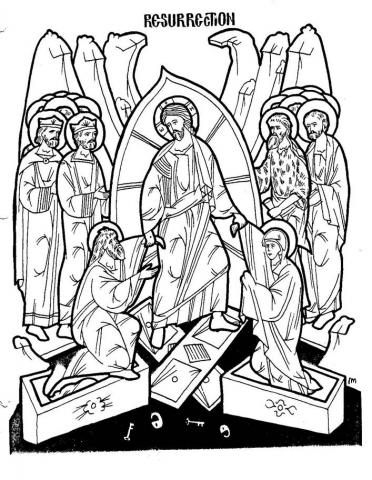
Doubting Thomas
DOUBTING THOMAS
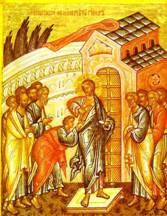
Objectives:
- Students should recognize the name of Thomas as a disciple.
- Students should be able to tell the story of Thomas in their own words.
Possible Lesson Plan:
- Open with prayer.
- Scripture Reference: John 20:24-29. Who was Thomas? What happened to the other disciples? Was Thomas there? What did Thomas say? What did Jesus do? How did Thomas respond? Why is he known as “Doubting Thomas”?
- Talk a bit about doubt: Has someone ever told you something that was hard to believe? If someone told you he saw a dead man walking around, would that be hard to believe? Did Thomas believe the other disciples? Would you? Talk a bit about the normal, expected way things usually are. Can the students describe some things that we know should happen in a certain way or look a certain way? Maybe, things fall down, not up; we walk on our feet and not our heads; leaves are green and not purple. Life is full of normal, everyday things and it would be impossible to live life otherwise. Imagine a world where things fell up, down, or sideways at random, where …But, do things always have to be normal? Is God in charge? Can He change anything He wants when He needs to? So He can and did change death, and surprised poor Thomas.
- Play a learning game: Don’t Make a Move. Take 10 popsicle sticks, numbered 1-10, and drop in a pile on the floor. Write 10 questions about today’s lesson on 10 numbered pieces of paper. Each player, in turn, attempts to pick up a stick without disturbing the rest. If successful, he gets to try to answer the question with the same number and earns a point if correct. If he moves the other sticks, or cannot answer the question, play passes to the next player.
- Add to your time line as usual.
- Close with prayer.
Myrrh-bearing Women
THE MYRRH-BEARING WOMEN
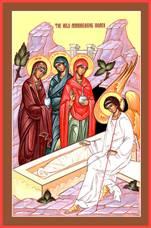 Objectives:
Objectives:
- Students should be able to say the word “myrrh” and know its meaning.
- Students should be able to tell the story of the myrrh-bearing women in their own words.
Possible Lesson Plan:
- Open with prayer.
- Scripture References: Luke 23:55-24:9, Mark 16: 1-11. Like the disciples, these women had followed Jesus all the way from Galilee to Jerusalem. They had listened to His teachings and knew His words were true. These women were very brave. In spite of the Roman soldiers and the mocking crowd, they followed our Lord to His cross. When all of the disciples (except whom? John) and run away, they had stayed at the cross. They went with our Lord to His burial. There are eight women typically depicted in the icon of the Holy Myrrh-bearers – Mary the Theotokos, Mary Magdalene, Joanna, Solome, Mary the wife of Cleopas, Susanna, and Mary and Martha of Bethany (sisters of Lazarus). Why were women going to the tomb? Why on Sunday? What is myrrh? What did they find? What did they do?
- Discussion: What is the meaning of death? Why does God allow death? How did death enter the world? How does the world around us explain death? If death is the end of everything, how would you live? How do other religions view death? In what way would say that our entire spiritual life is a preparation for death? Are you afraid of dying? Why or why not? Does God care if we die? (Remember, “Jesus wept.”) Has anyone ever escaped death? Did Mary die? How do we know we have victory over death? (the resurrection)
- Discuss burial customs. What are our customs? (“Memory Eternal” or eating koliva?) The Jewish custom was to rub the body with myrrh. Why couldn’t the women do it Friday night? (the Sabbath) Where was Jesus’s body put after He died? Can you remember whose tomb it was? We usually bury people in the ground and fill the grave with dirt. How was the tomb of Jesus sealed? (stone) How did the women feel when the stone was rolled away? How would you feel if the grave of a loved one were found dug up? But, Jesus’s body wasn’t stolen; He told the women He had risen from the dead! How did they feel now? What did they do?
- Play a learning game: Verse Scramble. Divide the class into 2 teams. Choose 5-10 verses or pieces of verses from today’s lesson. Make two identical sets of cards for each verse, one for each team. Each set should consist of several cards, each card with 1-3 words from the verse. Mix up the cards for each verse and paperclip together until class time. Place the first set of cards in front of each team. At “Go” the team tries to arrange the cards in order. When they are all in place, the players stand holding the cards so the verse can be read in order. That team gets the point. Then, move on to the next verse. Suggested verses?
Mark 16:2 Mark 16:5 Mark 16:6 2nd part
Luke 24:2 Luke 24:5 (quote) Luke 24:9
- Add to your time line as usual.
- Close with prayer. Consider the "holy myrrhbearers" of your own parish, those women who silently serve with sweet-smelling flowers, decorate the tomb, prepare the candles, and pray for them especially.
Road to Emmaeus
THE ROAD TO EMMAEUS
Objectives:
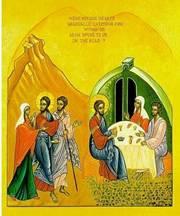 Students should be able to tell the story of the road to Emmaeus.
Students should be able to tell the story of the road to Emmaeus.- Students should know the significance of the disciples recognizing Jesus in the breaking of the bread.
Possible Lesson Plan:
1. Open with prayer.
2. Scripture Reference: Luke 23:13-39. Where were the men going? Find it on a map? Why? Who was the stranger? When did they know that He was Jesus? Review the story of the Last Supper, when Jesus last broke bread with His disciples. Review some of the other appearances of Jesus after His resurrection – to Mary Magdalene, to the disciples and Thomas. In John 21:1-17, we read of yet another, to the disciples fishing. How did they recognize Jesus this time?
3. This is a good time to review, as Jesus did, the span of the Old Testament and prophets and what they said about the Messiah. When did people first disobey God? Review the story of Adam and Eve. Over and over, God saved His people: Noah and the ark, Abraham and Isaac, Moses and Passover, Jonah and the big fish, the three boys in the fire, Daniel in the lion’s den. In each case, God provided the means of saving His people. What were they? (ark, ram, blood of lamb, fish, Jesus Himself, an angel) He gave His people His law, the Ten Commandments, but they disobeyed even that. Now He has given His Son to save us all!
4. Play a learning game: Map Search – a review. Divide into teams. Using the original blank map from earlier in the year, ask the first team to locate one of the places marked or Emmaeus. If they locate it correctly, they receive the point and get another turn. If they cannot, the missed place passes to the other team for a try at a point. Continue until all places are correctly identified.
5. Make Prosphora in class. Ask Fr. Gregory if you can use the kitchen. It would be best to mix the dough at home:
3 cups warm water Mix warm water and yeast
2 tablespoons fast rise yeast first
5 pounds bread flour Add flour, salt, and cool
3 cups cool water water and knead.
1 ½ tablespoons salt
Let the dough rise during Liturgy in the kitchen (not in oven). Divide into a loaf for each child and let the children knead and shape the loaves and stamp them. Take them home again to bake. Help each child to make a list of relatives, living and dead, for Father to pray for.
6. Add to your time line as usual.
7. Close with prayer.
Ascension
ASCENSION
Objectives:
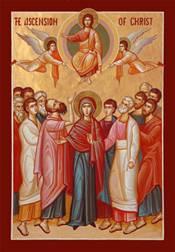 Students should understand the icon and its characters and be able to tell the story of the Ascension.
Students should understand the icon and its characters and be able to tell the story of the Ascension.
- Students should know that Ascension occurs 40 days after Pascha.
Possible Lesson Plan:
- Open with prayer.
- Review the icon, seeing how much they already know: Christ is the central figure, clothed in white (Why?) and bestowing a blessing on the world with hands outstretched, the Theotokos just below Christ, the disciples (including whom as a replacement for Judas? Matthias) Are they in the city or the countryside?
- Scripture References: Mark 16:15-19, Matthew 28:16-end, Acts 1: 1-12
- Troparion: Thou has ascended in glory, O Christ our God, and gladdened Thy disciples with the promise of the Holy Spirit, having become confident of the blessing. Verily, Thou art the Son of God, the Deliverer of the world!
- Discussion questions:
What were Jesus’s promises on Ascension? (there are 3: to send the Spirit, to be with them always, and to return in glory) Where did the Ascension occur? (on the Mount of Olives, near Bethany) In what way is the Ascension the crowning of the Paschal mystery? Which of the apostles pictured in the icon could not possibly have been there? (St. Paul) Why? (He was converted on the road to Damascus, much later.) Why is he pictured in the icon? (He was a witness to the resurrection just like the others since Jesus Himself appeared to Saul.)
Where does Jesus sit now? (at the right hand of the Father) Where is that? (the point here is that it is not an earthly place; thus the angels asked the bewildered disciples why they were looking at the sky) A cloud came and removed Jesus from the sight of His disciples; where else do we see a cloud with a divine appearance? (Red Sea, Mt. Sinai and the 10 Commandments, Mary at the Annunciation, Transfiguration) What did the apostles do between Ascension and Pentecost? (wait!!!) Compare and contrast Ascension and Transfiguration.
What did Jesus tell his disciples to do? What is the “Great Commission”? (“Go ye, therefore, and make disciples of all nations…”) Does that still apply to us? In what way? How can we implement this commandment in our own lives?
- Play a learning game: Outguesser. Give each student a piece of paper and pencil. Have them make 2 columns – People Present and Countries of the World. Give them a set time to list as many in each column as possible. When time is up, the student with the most correct answers is the winner.
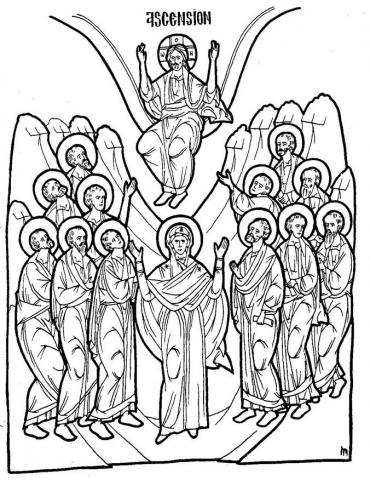
- Add to your time line as usual. Nearing the end, now.
8. Close with prayer.
Pentecost
PENTECOST

Objectives:
1. Students should understand the icon and its characters.
2. Students should know that “Pentecost” means “fiftieth” and is celebrated on the fiftieth day after Pascha.
3. Students should understand why Pentecost is called the birthday of the Church.
Possible Lesson Plan:
1. Open with prayer.
2. Review the icon; what do they already understand? The disciples are gathered in the upper room (What last happened there? the Last Supper), in some icons each has a flame above his head (Why?), the book of the Gospels sits in the center, by which the Holy Spirit has revealed the spiritual presence of Christ to the world, the little crowned figure seated in the middle is the world! There is an empty place at the top of the horseshoe formed by the apostles; who will fill this place at the Second Coming? The icon shows only 12 apostles; how many believers were actually there?
3. Scripture Reference: Acts 2
4. Songs of the Feast:
Troparion: Blessed art Thou, O Christ our God, Who hast revealed the fishermen as most wise, by sending down upon them the Holy Spirit; through them thou didst draw the world into thy net, O Lover of man, glory to Thee.
O Heavenly King: O heavenly King, the Comforter, the Spirit of Truth, Who art everywhere and fillest all things, Treasury of blessings and Giver of light, Come and abide with us, and cleanse us from every impurity, and save, O good One, our souls.
5. Discussion questions:
What happened at Pentecost? Who descended? Who is the Holy Spirit? In which other feast did we meet the Holy Spirit? (as a dove at Theophany) In what sacrament do we receive the Holy Spirit? (Chrismation) Review where the symbolism of the oil came from (last lesson). In the Old
Testament, only the prophets were filled with the Spirit; how does this differ from the New Testament? How is this expressed by the prophets? The word “chrismation” comes from what? (Greek “chrisma” meaning anointing) How does the Spirit, God Himself, dwell in us? How can we tell He does – did we see tongues of fire? This is a great mystery, as are all the sacraments. Why is He called “Comforter”? In our prayer, “O heavenly King” we ask the Holy Spirit to come, why? (Jesus commanded us in Luke 11: 9-13.)
Why do we decorate the Church in green? (as a sign of the life the Holy Spirit brings us) In what way is Pentecost the birthday of the church? (the first Christians were baptized by the apostles) What changed the frightened disciples into the power-filled apostles? How did the apostles use their new power in the Holy Spirit?
What is speaking in tongues? (speaking in other languages as the apostles did at Pentecost) How is this different from the tower of Babel? (Here we see harmony and subjection to God’s action; there we see confusion and disunity from an attempt by man to reach God by his own means, resulting in hatred, racism, and war.)
Why were there so many Jews in Jerusalem from all over the world at that time (50 days after Passover) anyway? (They are also celebrating Pentecost, the giving of the Law 50 days after Passover on Mt. Sinai; it is also the “Feast of Weeks” and the thanksgiving for the harvest) So the Old Covenant Pentecost, the Law, is supplanted by the New Covenant Pentecost, the Spirit.
How do we end the Pentecost celebration? (with kneeling vespers, we again kneel in a spirit of penitence, which we will keep until the next Paschal season) What does it mean to say, Christ saves but the Holy Spirit sanctifies? What does it mean to be a Temple of the Holy Spirit (I Cor. 6:19)? How can we desecrate that Temple? How can we renew the gift of the Holy Spirit in our daily lives? How might we ask the Holy Spirit to guide and fill us?
6. Play a learning game: Alphabet Search. Bring in your Scrabble tiles or make small squares of paper with letters on them – 2 full sets and several extra of each vowel. Place the squares in the center of the room. Ask a question from the lesson that can be answered with one word. The first player to lay out squares to spell the correct word is the winner of that round.
7. Add to your time line as usual. This is the last one! Tie the whole thing together?
8. Close with prayer, “O Heavenly King.”
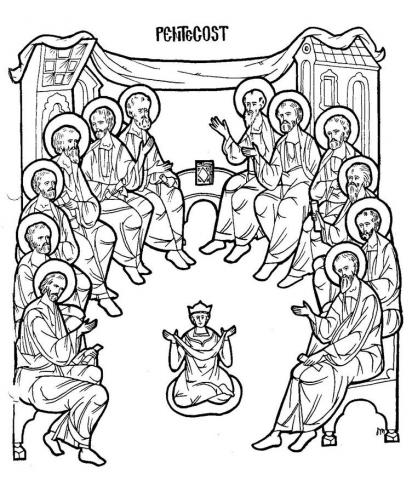
Lord's Prayer
- THE LORD’S PRAYER
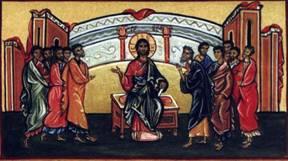 Objectives:
Objectives:
- Students should identify the Lord’s Prayer, or “Our Father”, as the prayer that Jesus taught His disciples.
- Students should memorize the Lord’s Prayer.
Possible Lesson Plan:
- Open with prayer. Use the Lord’s Prayer.
“Our Father”: What’s a father like? Who is your father on earth? How is God like/different from your father on earth? St. Cyril of Alexandria points out that, by calling God "our father” we are placed in a relationship to God like that of Jesus, both a privilege and a responsibility.
“Who art in Heaven”: Where does God live? What’s heaven like?
“Hallowed be Thy name”: “Hallowed” means “holy”; what does holy mean?
“Thy kingdom come”: What is God’s kingdom? Who desires the coming of the kingdom of heaven to come, the saints or the wicked?
“Thy will be done on earth as it is in heaven”: Why do things happen to us? Who is in charge?
“Give us this day our daily bread”: Remember the Sermon on the Mount? God even feeds us and takes care of us. Review the feeding of the 5000. St. Ephraim the Syrian points out that Jesus may mean here both physical bread for our bodies and the spiritual “bread” of His body in communion.
“Forgive us our trespasses”: Do we ever do anything wrong? Do we need forgiveness?
“As we forgive those who trespass against us”: Has anyone ever done anything unkind to you? Have you forgiven that person?
“And lead us not into temptation”: Remember Jesus’s temptations? Is it hard to always obey God?
“But deliver us from evil”: Who is the source of evil? Did Jesus win even over the devil?
- Scripture Reference: Matthew 6:5-15. The disciples asked Jesus how to pray the right way. This is the prayer Jesus gave them. Go through the prayer line by line with the students:
- Discussion: When and where do we pray? Ask the students how prayer is done in their homes. Do they pray before meals? Do they pray in the morning or the evening? Do they have an icon corner? Do they pray at bedtime? Remind them to say the Lord’s Prayer every morning and evening.
- Play a learning game: Verse Scramble. Write each line of the prayer on a separate piece of paper. Give each player a piece. They must line up in order, then read the whole prayer in order with each player reading his own card.
- Add to your time line as usual. Go back to the Sermon on the Mount and add it if you didn’t include it then!
- Close with the Lord’s Prayer.